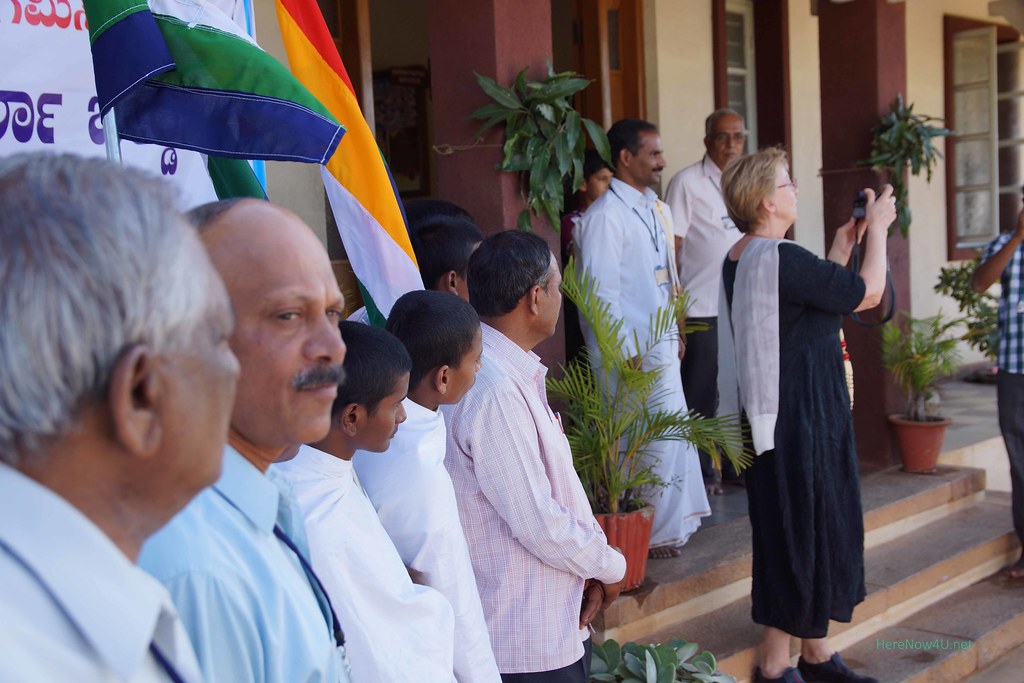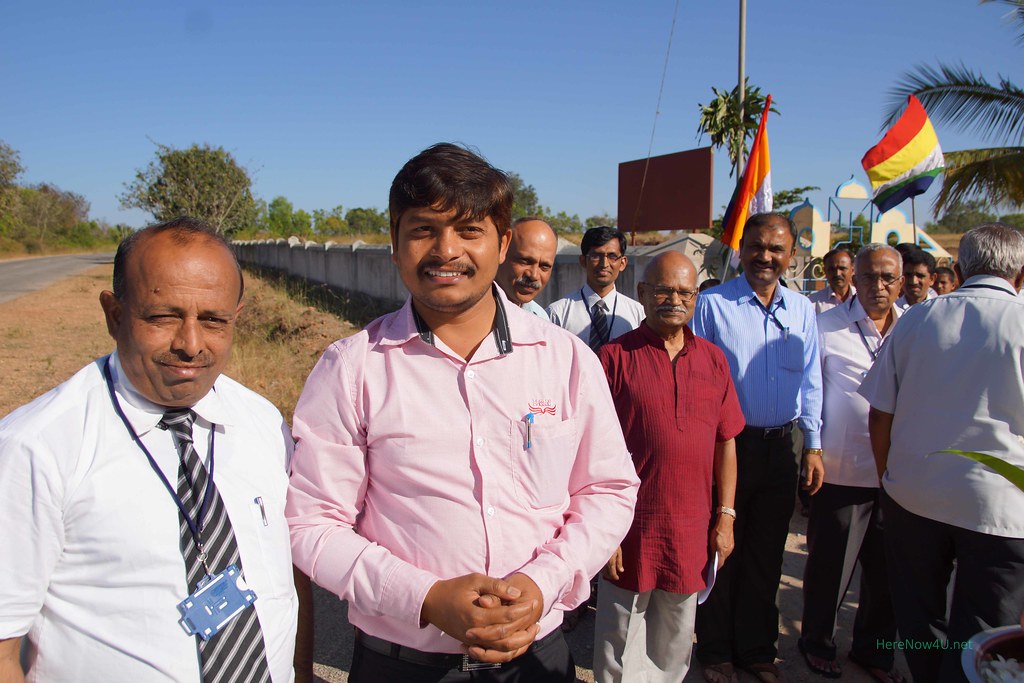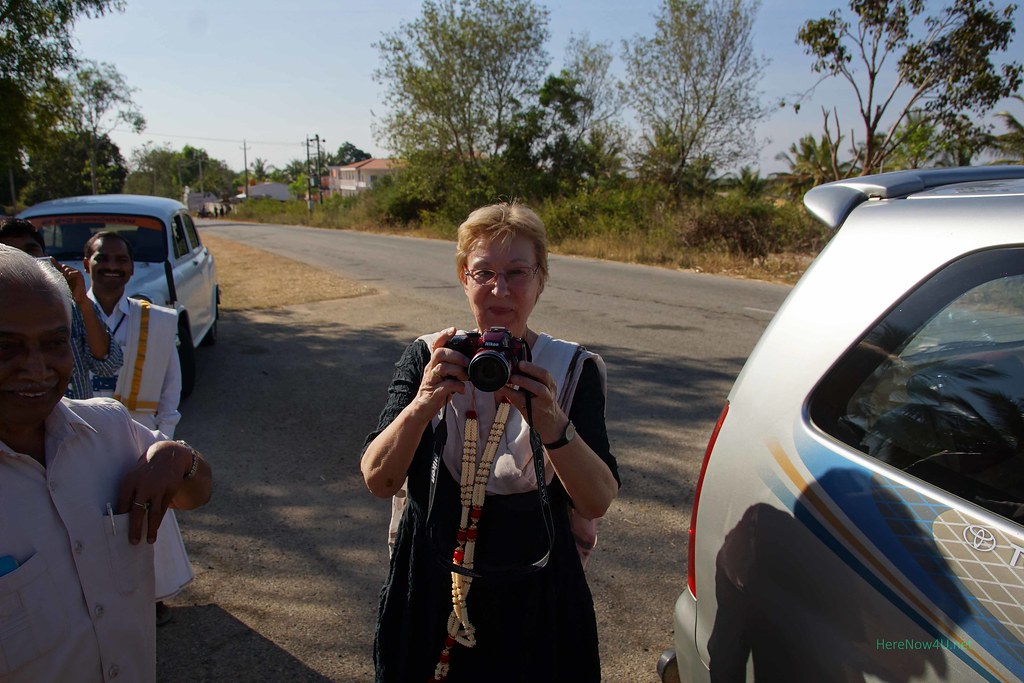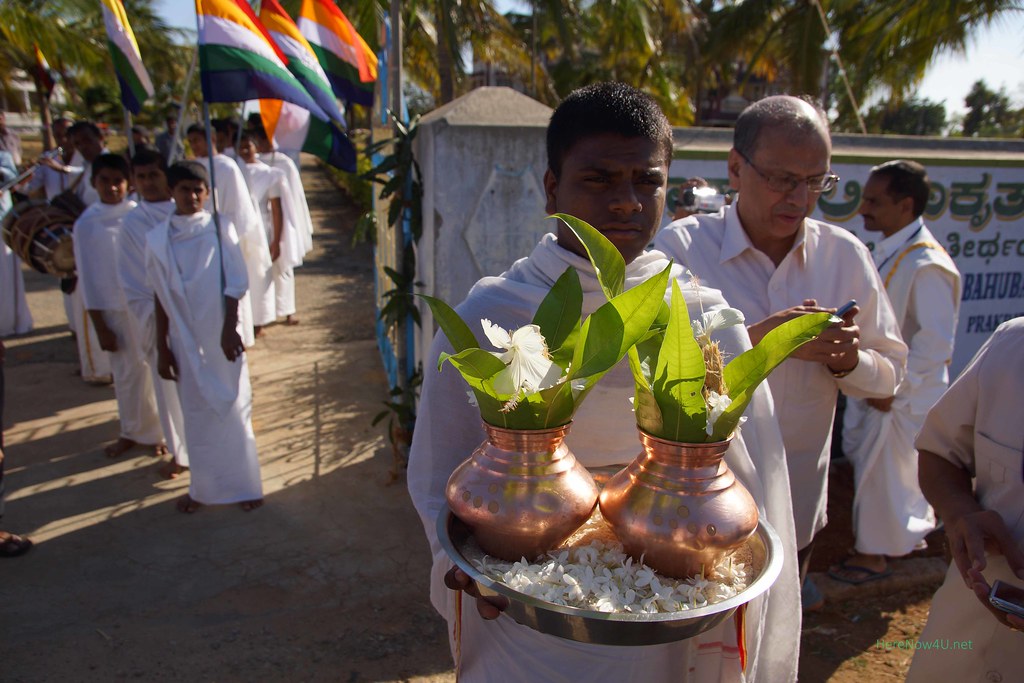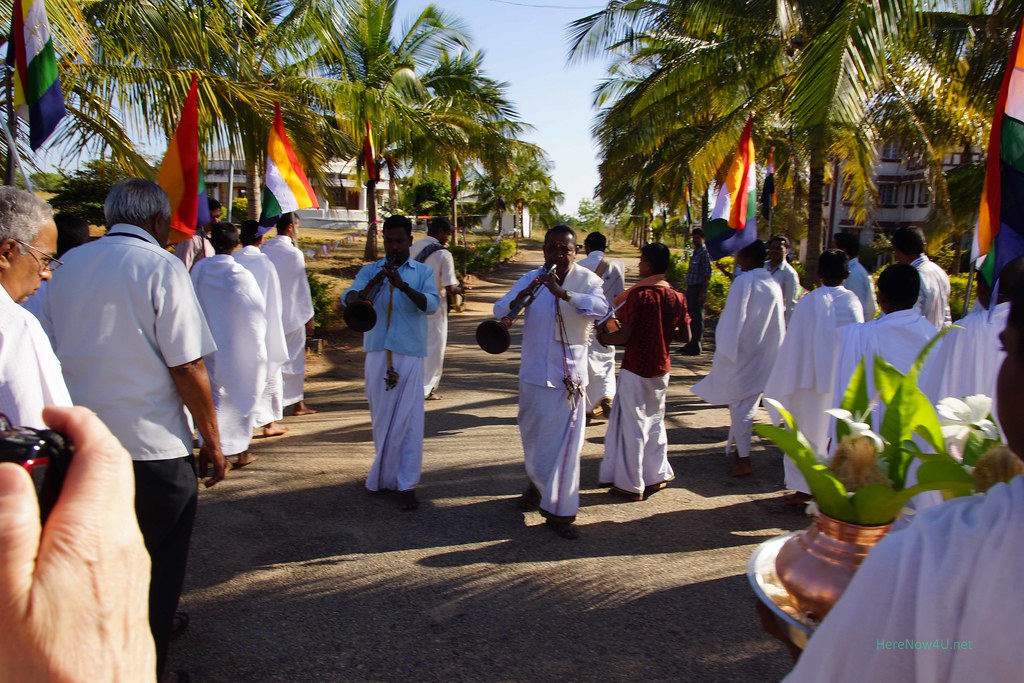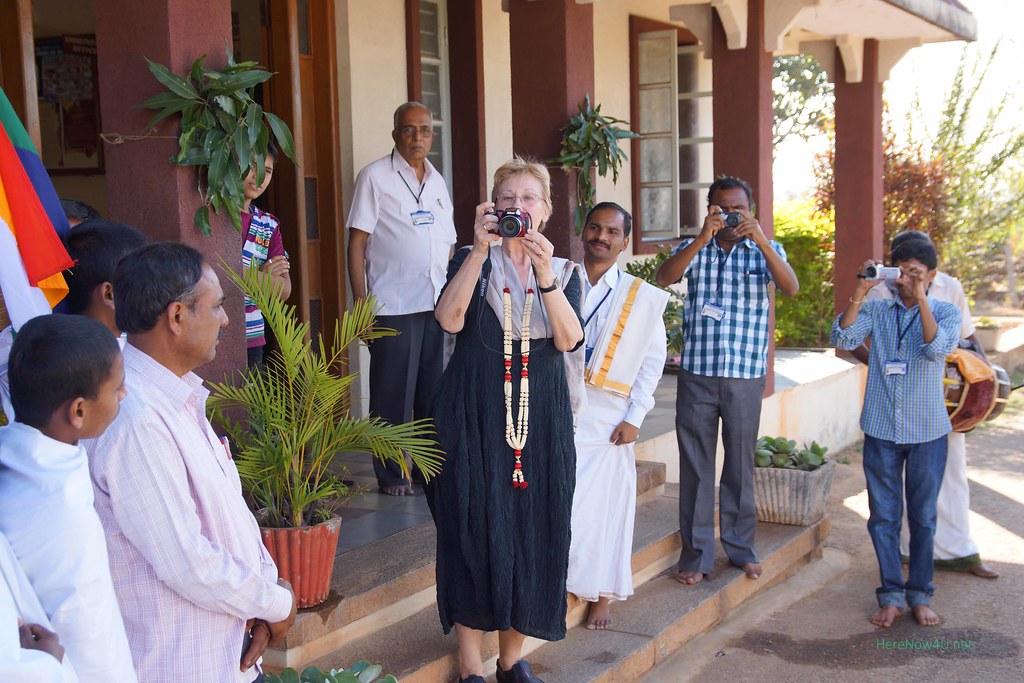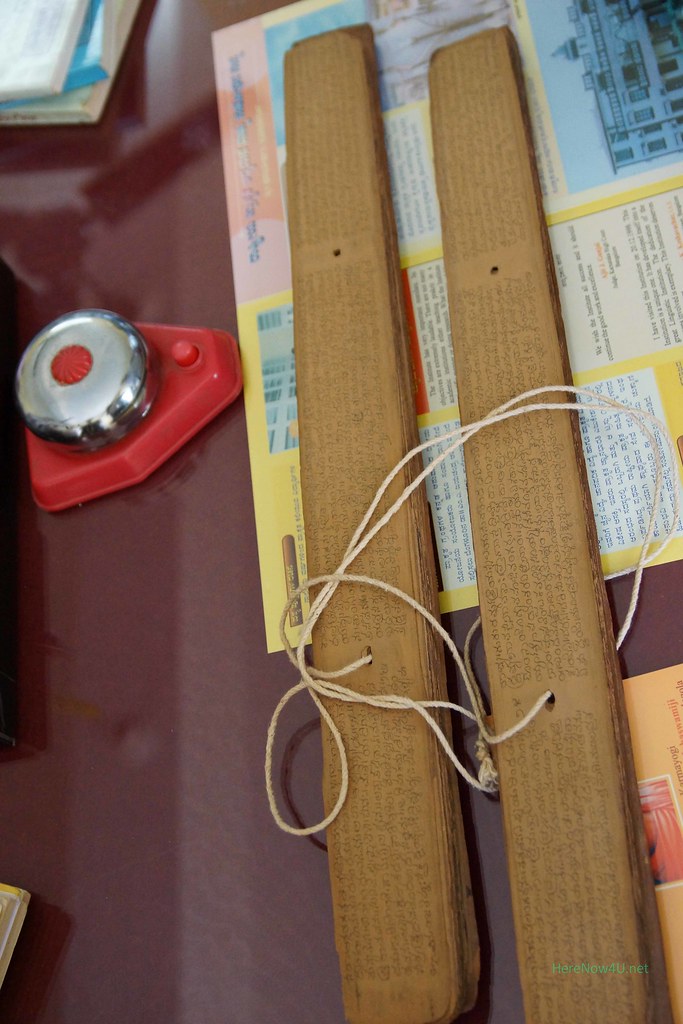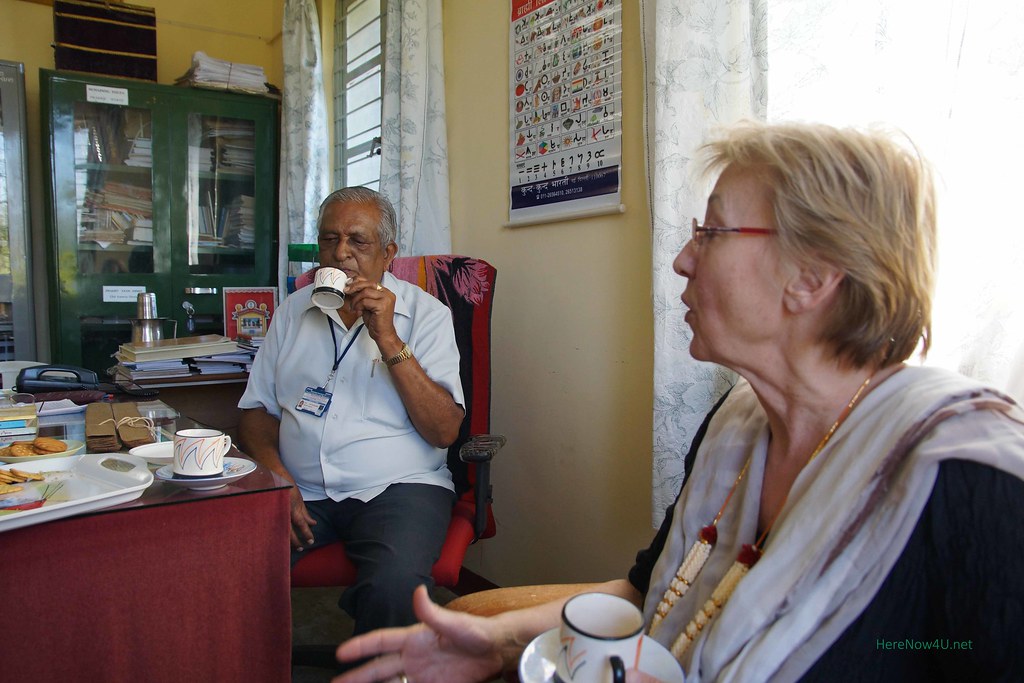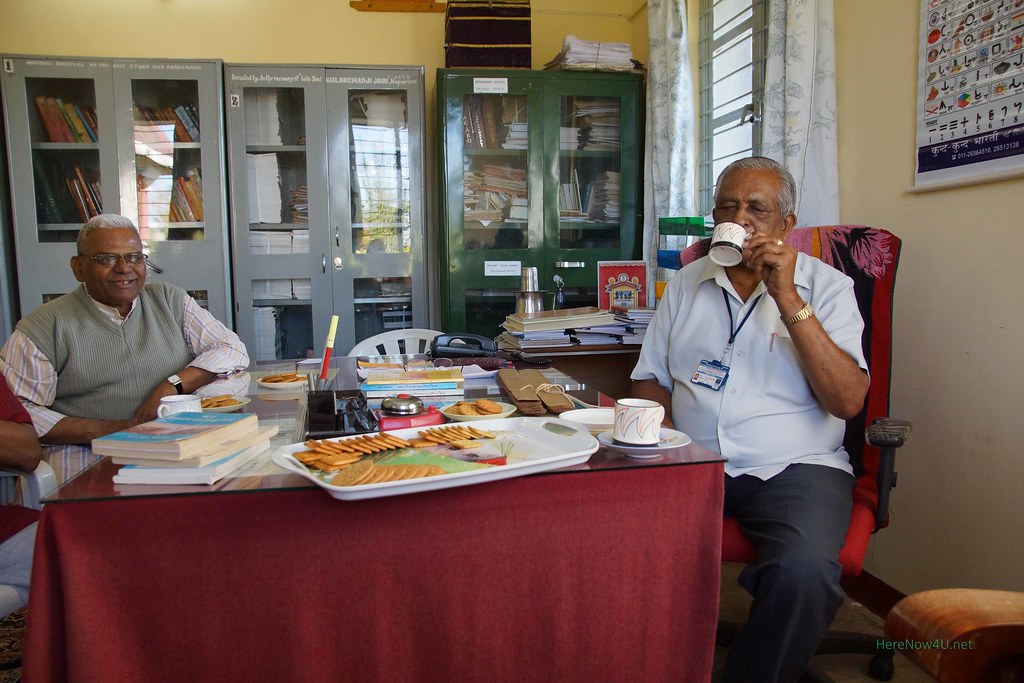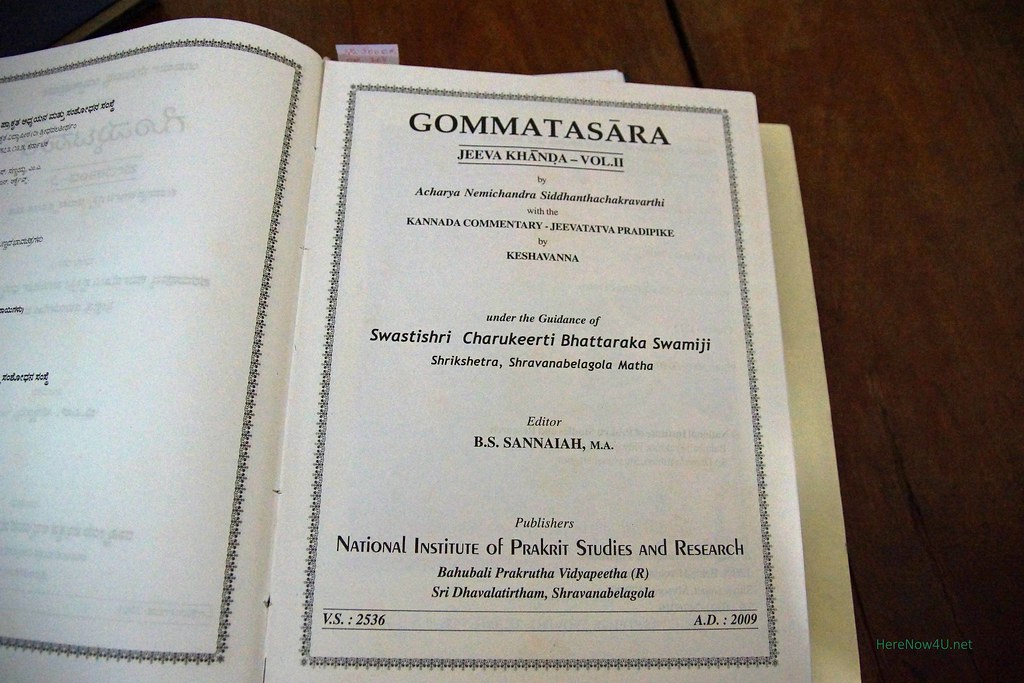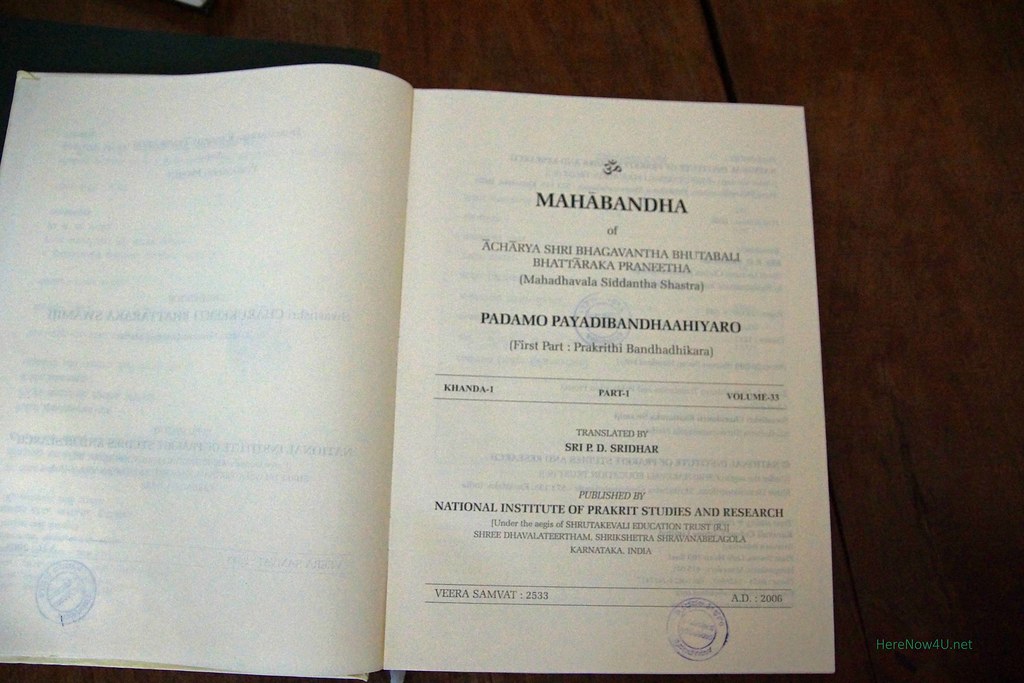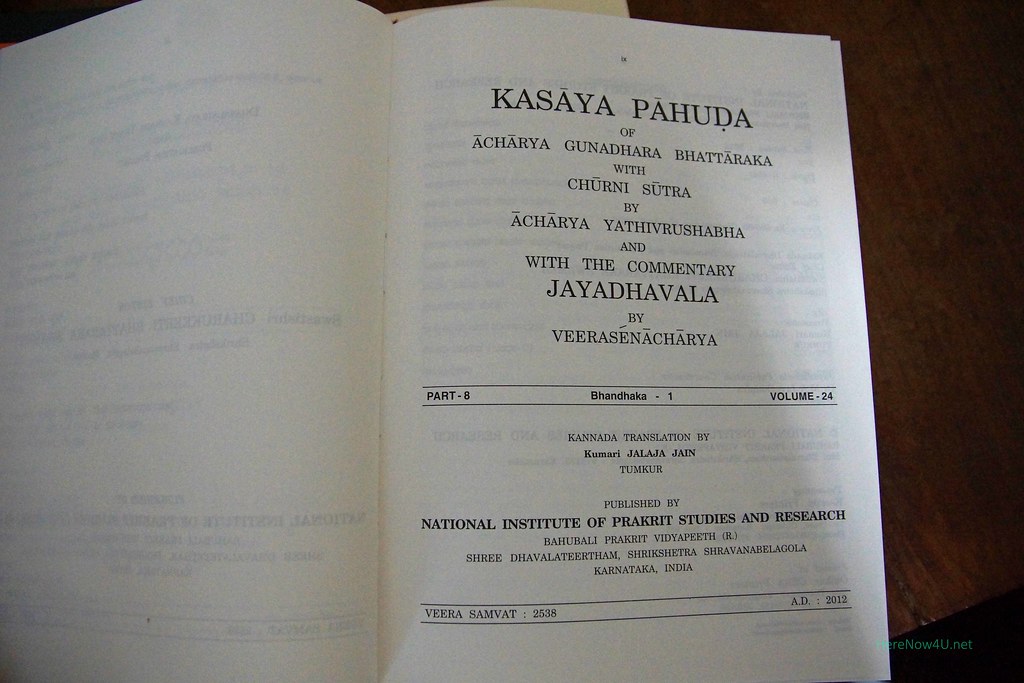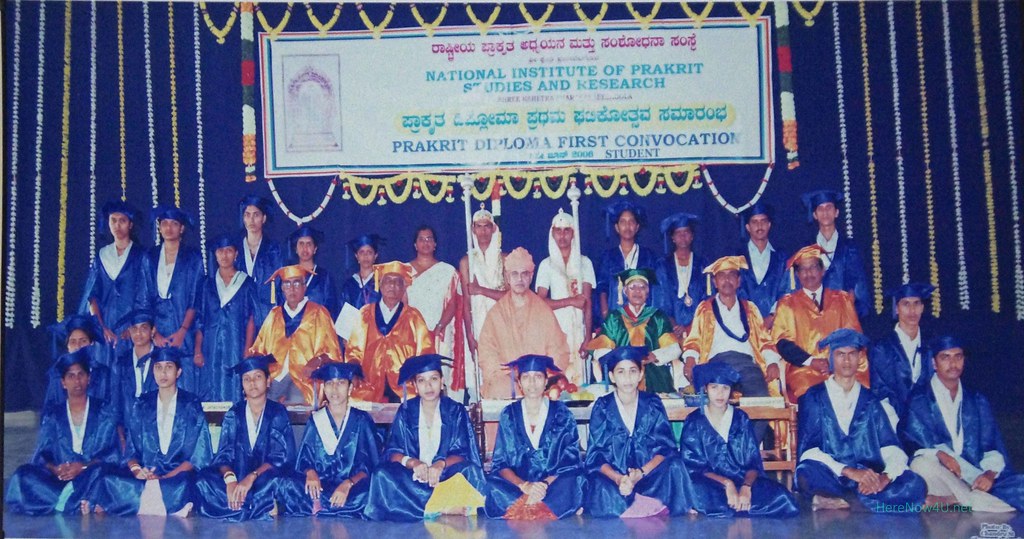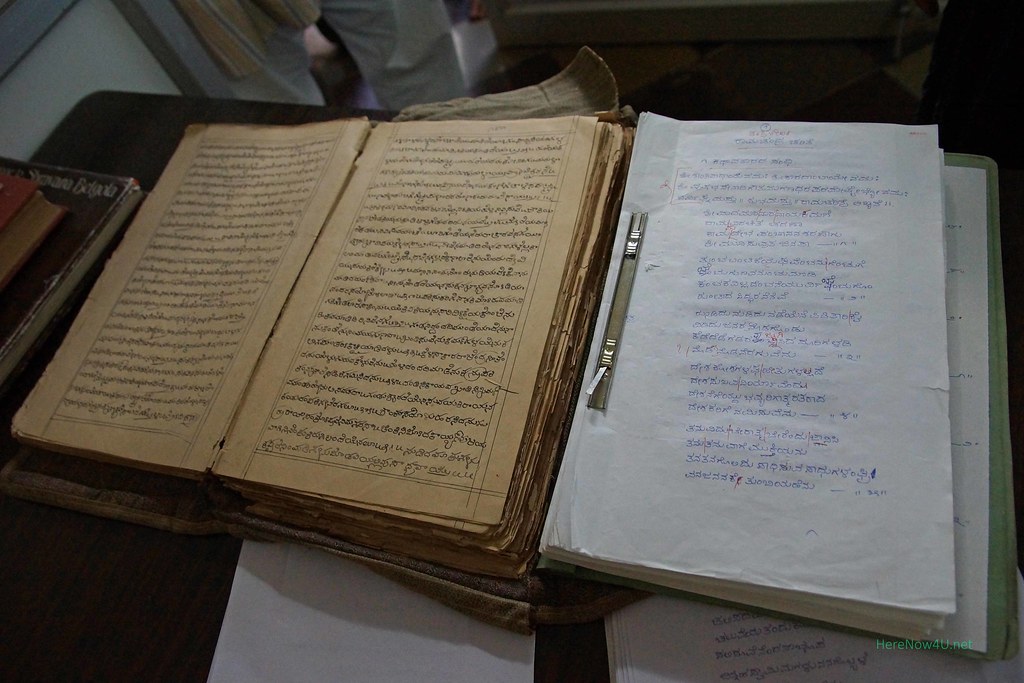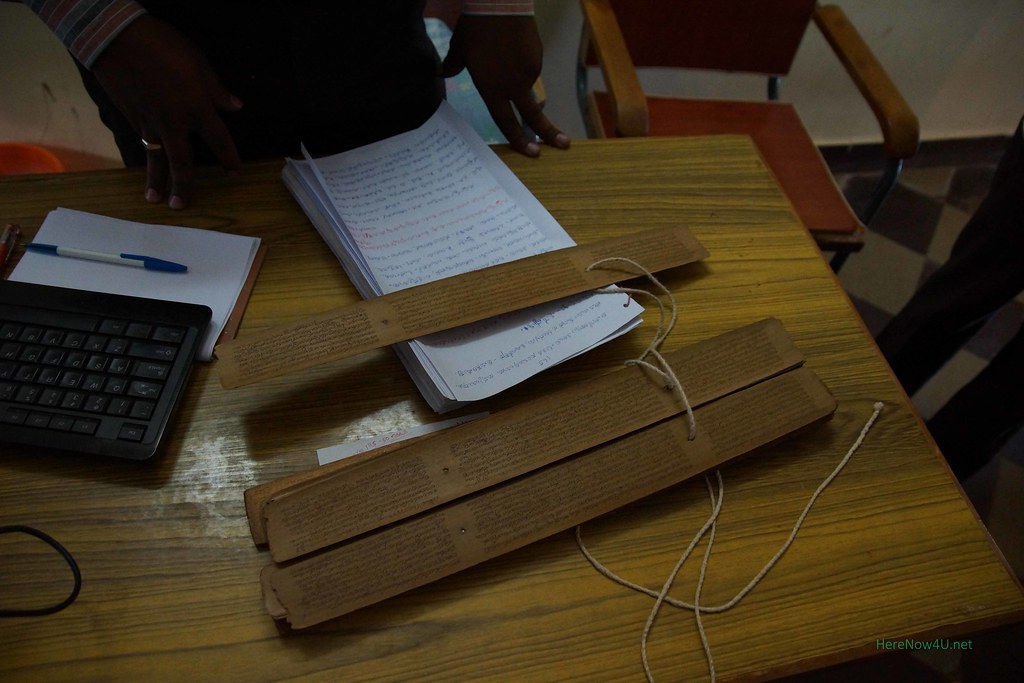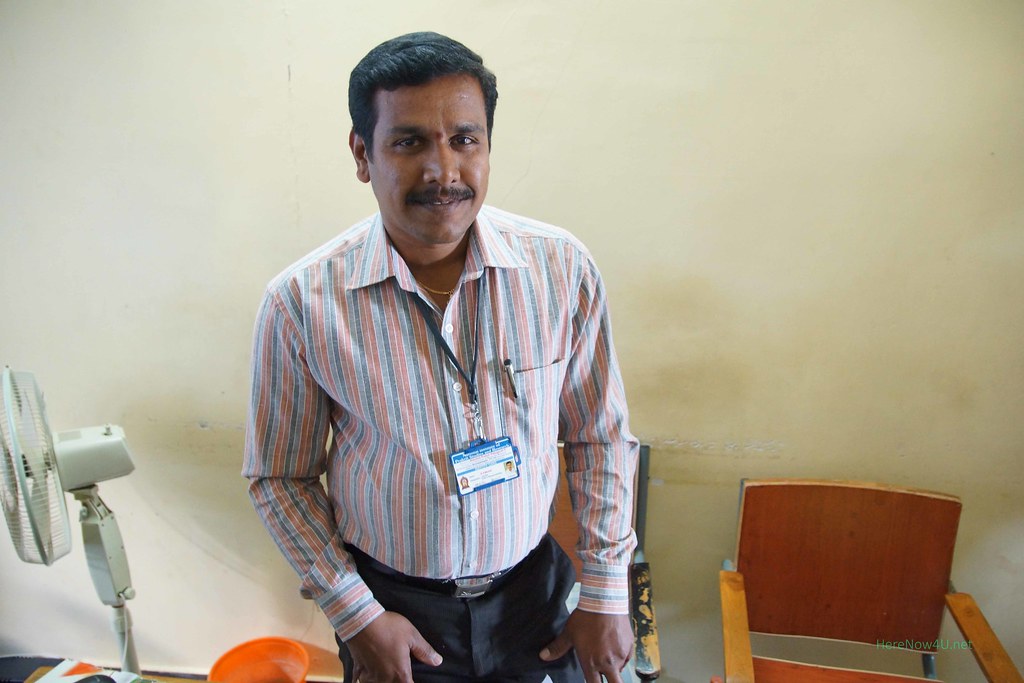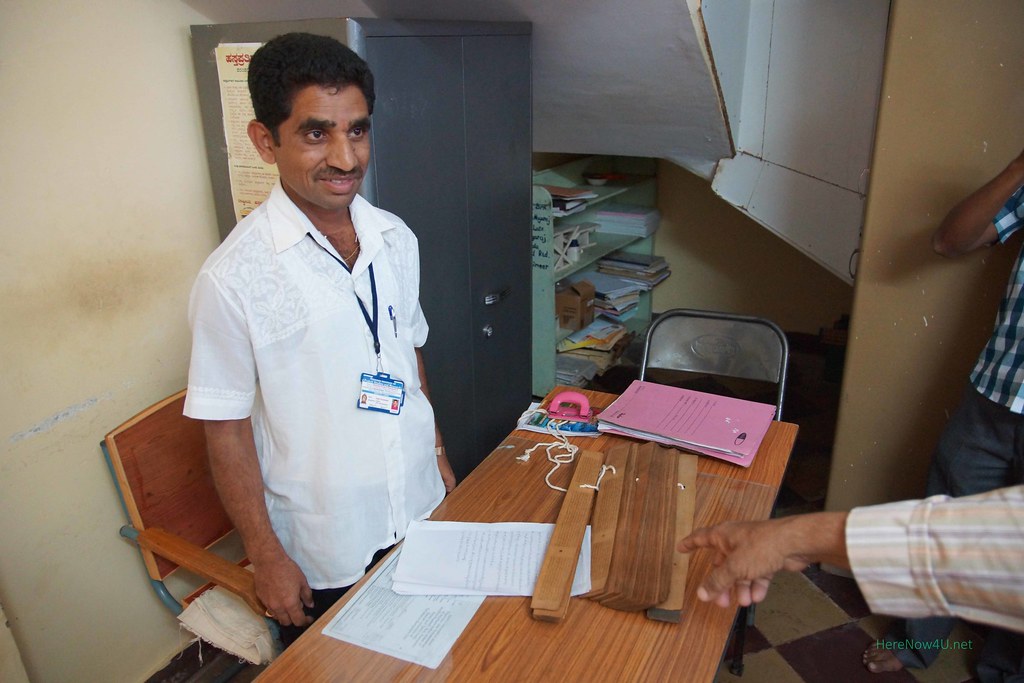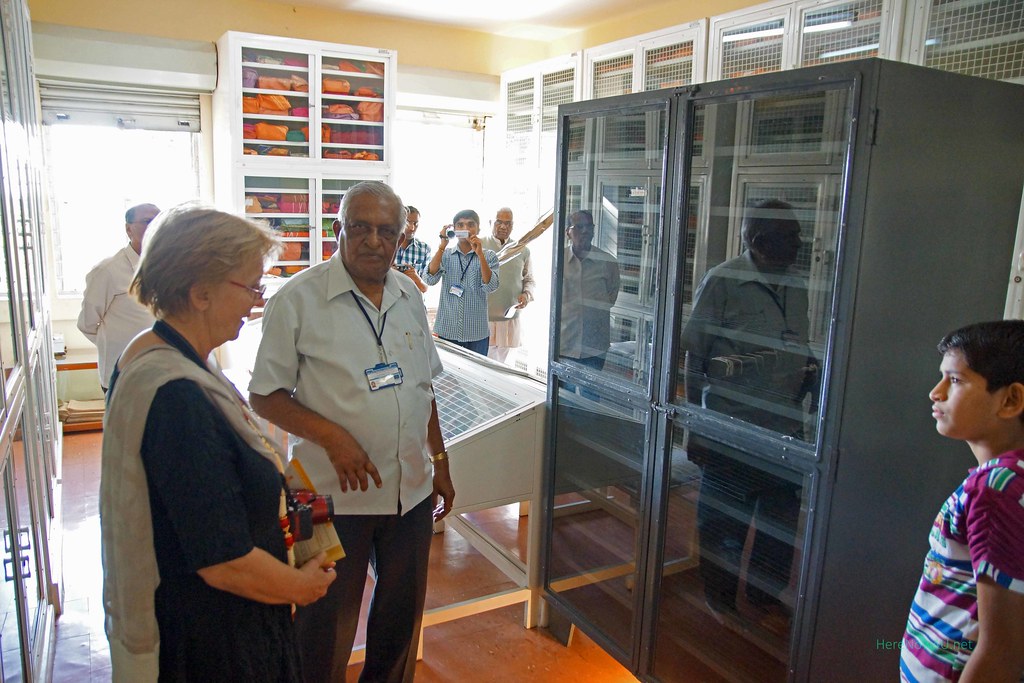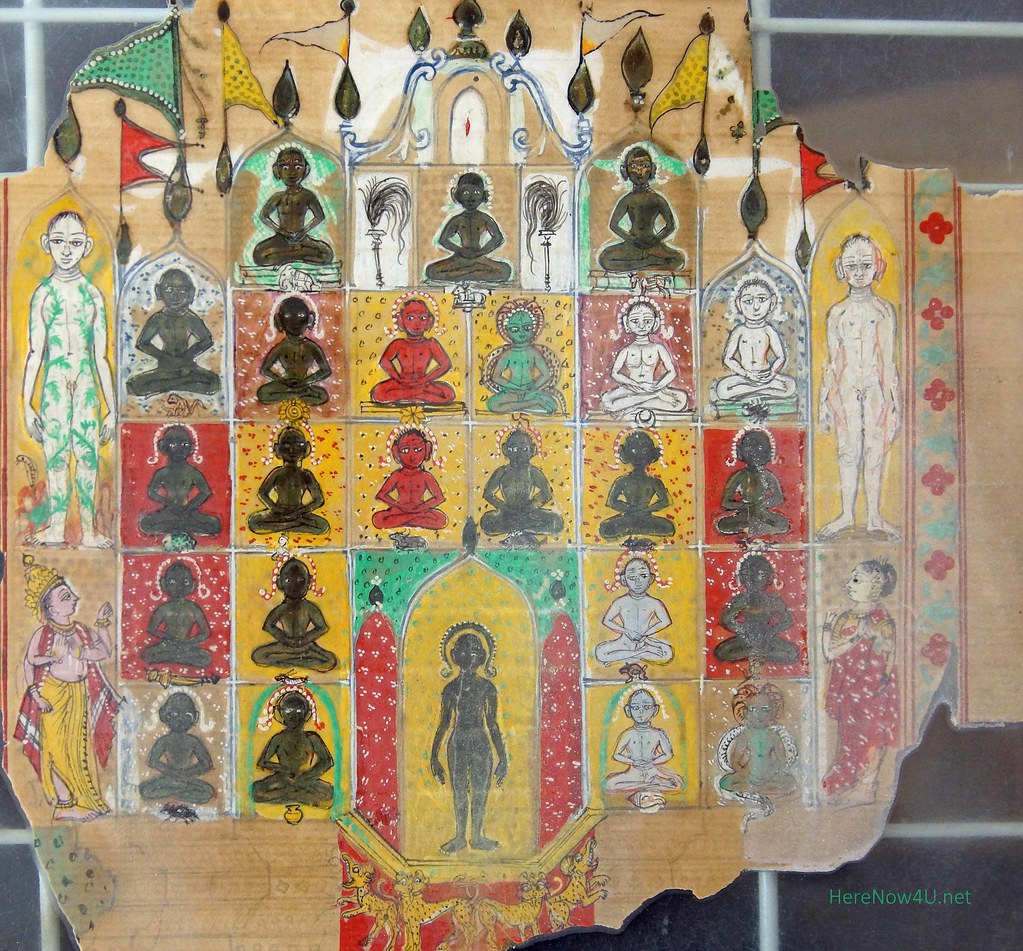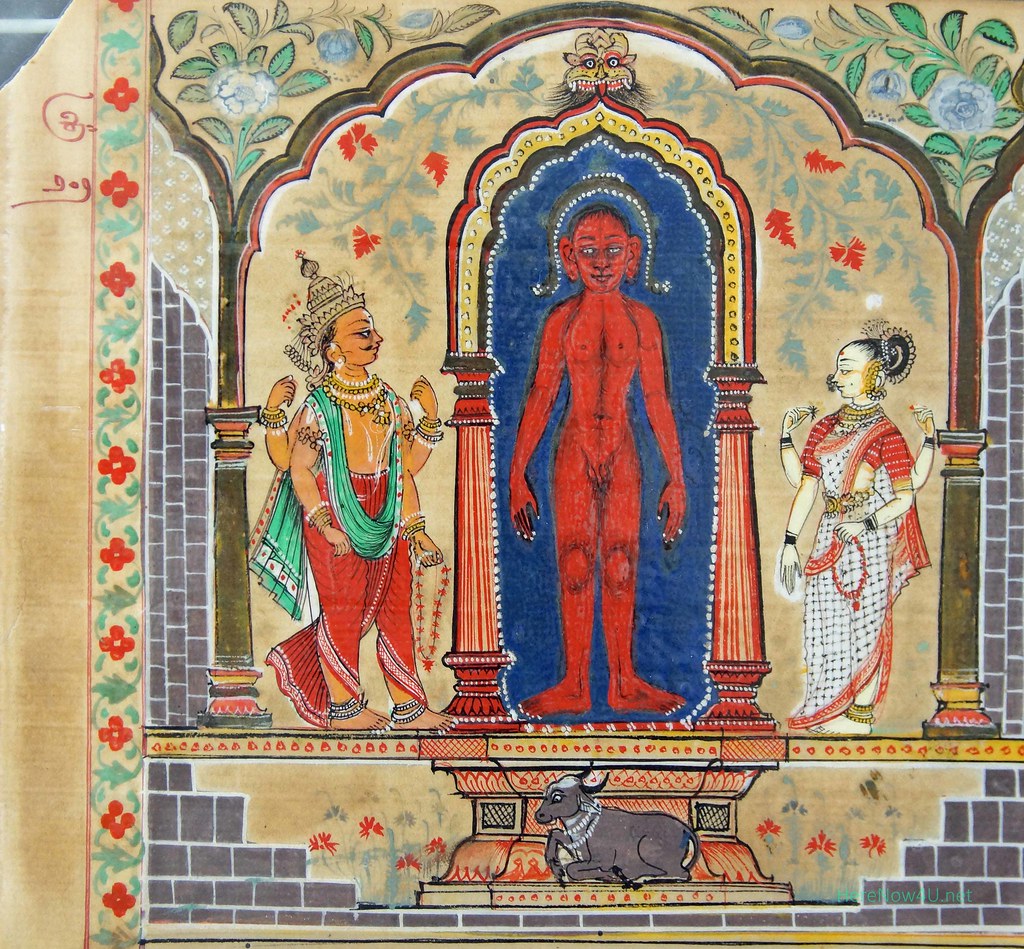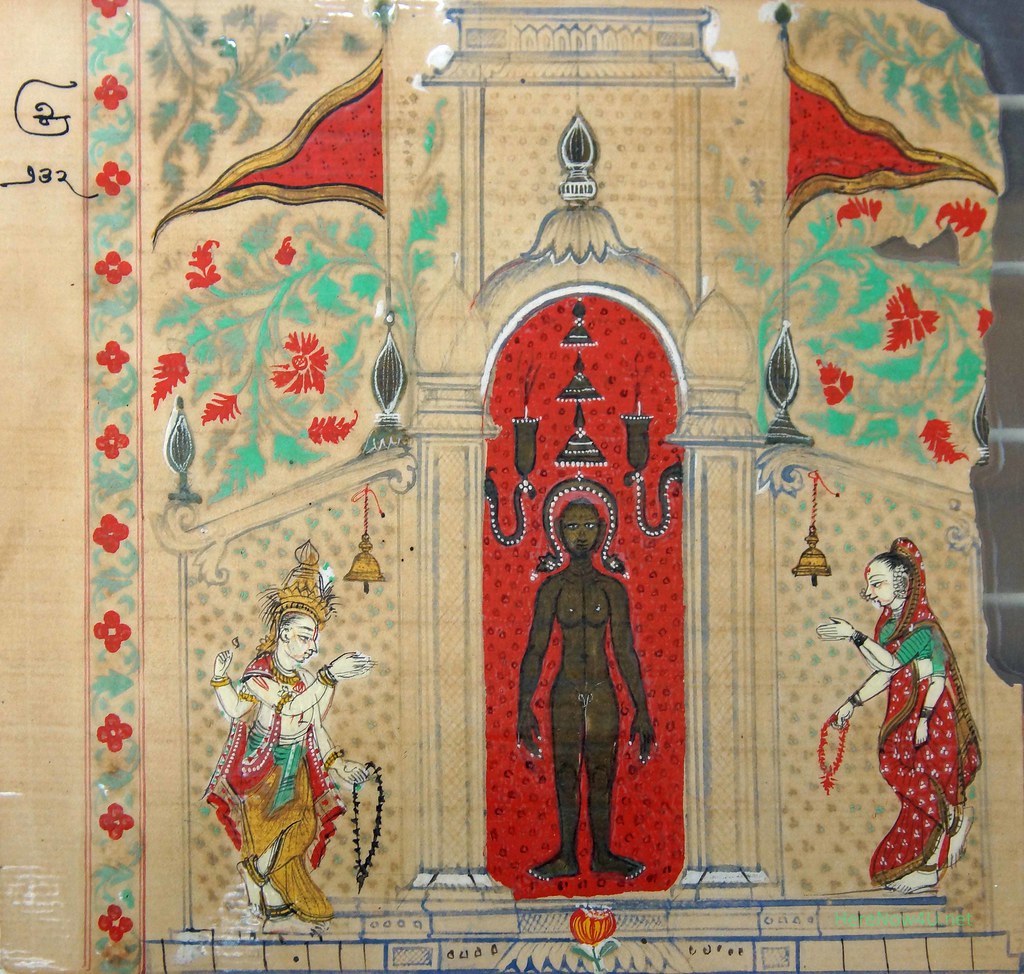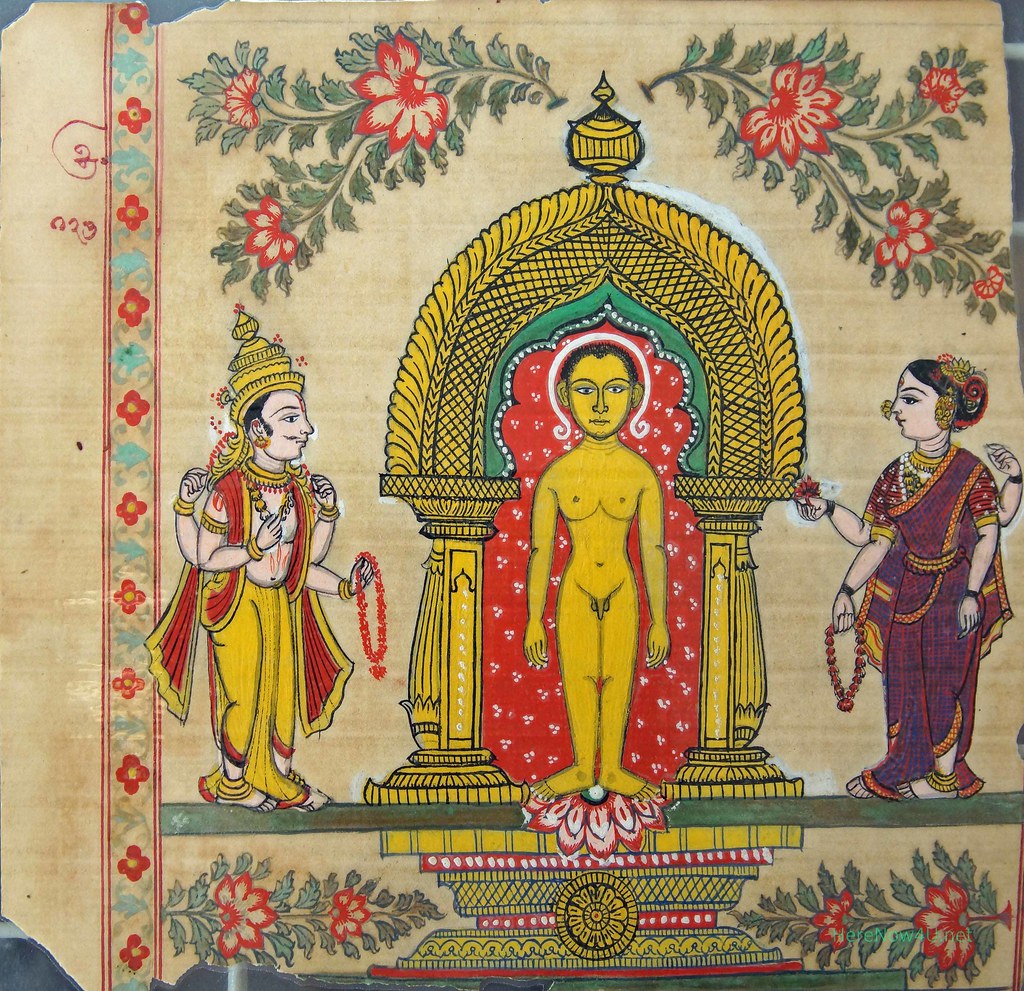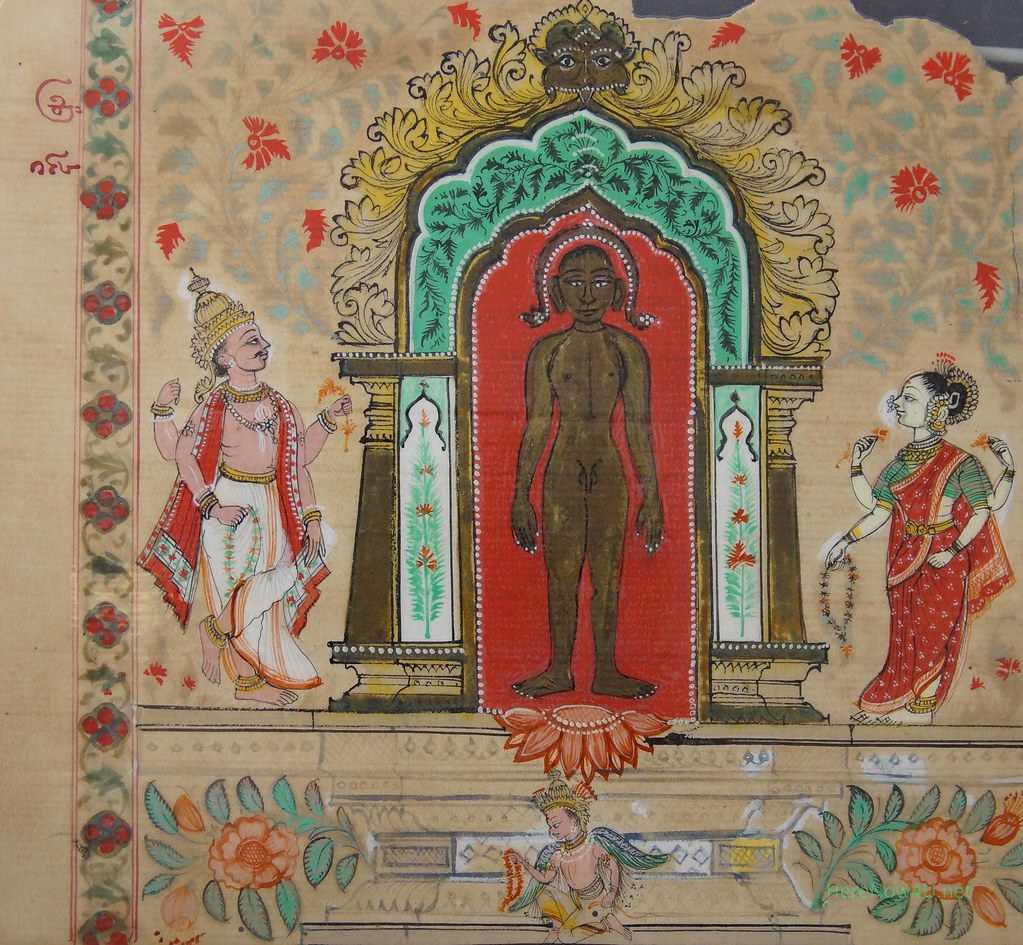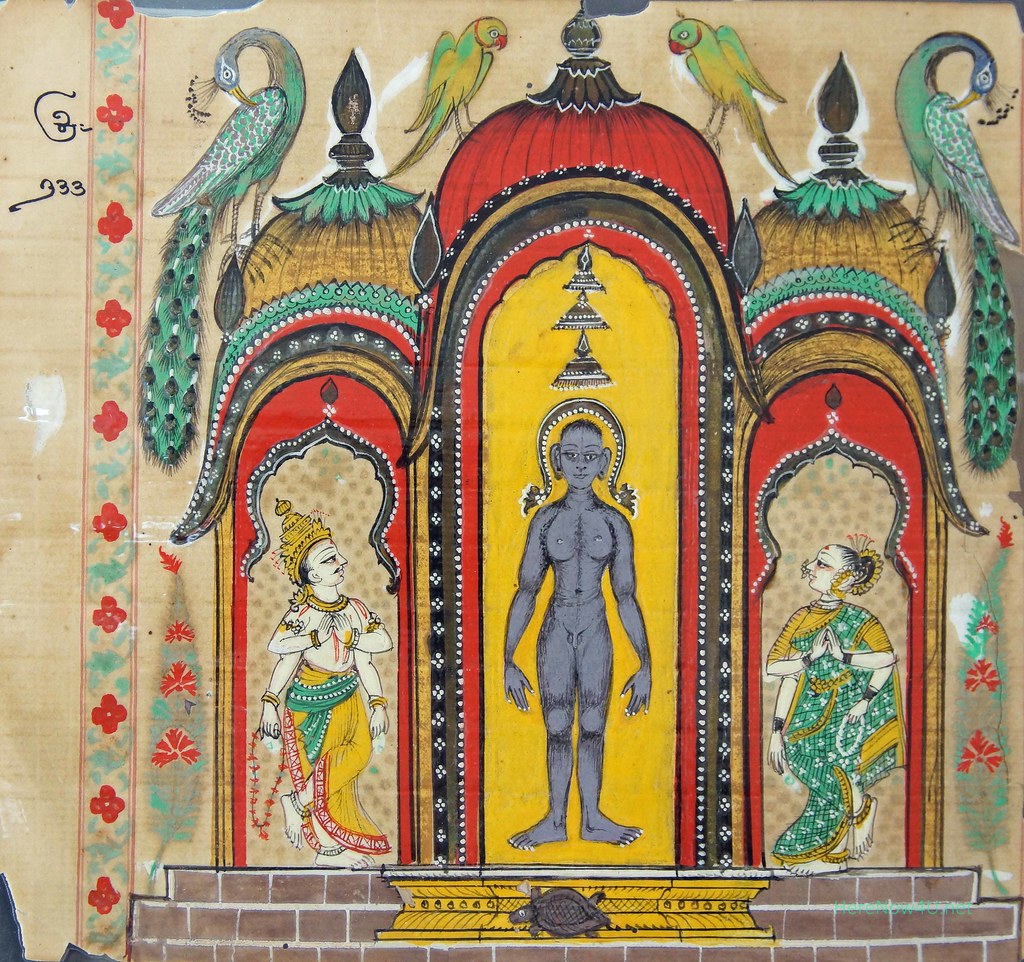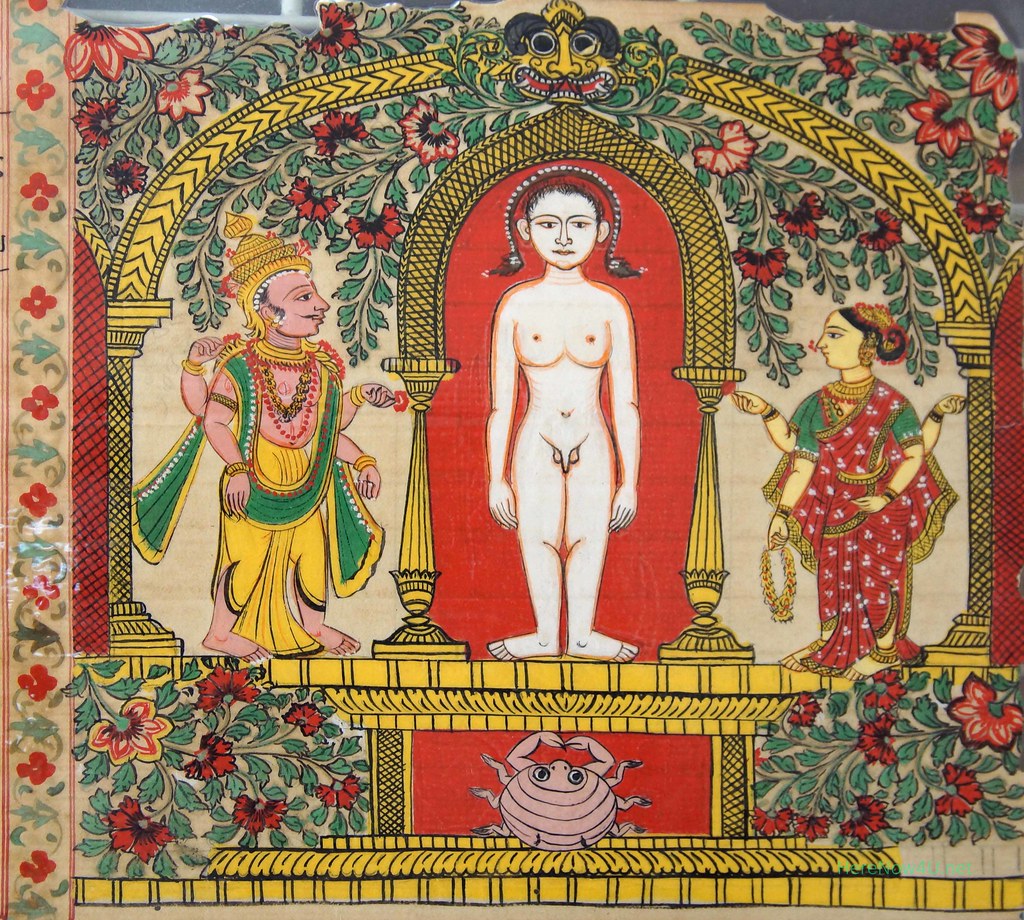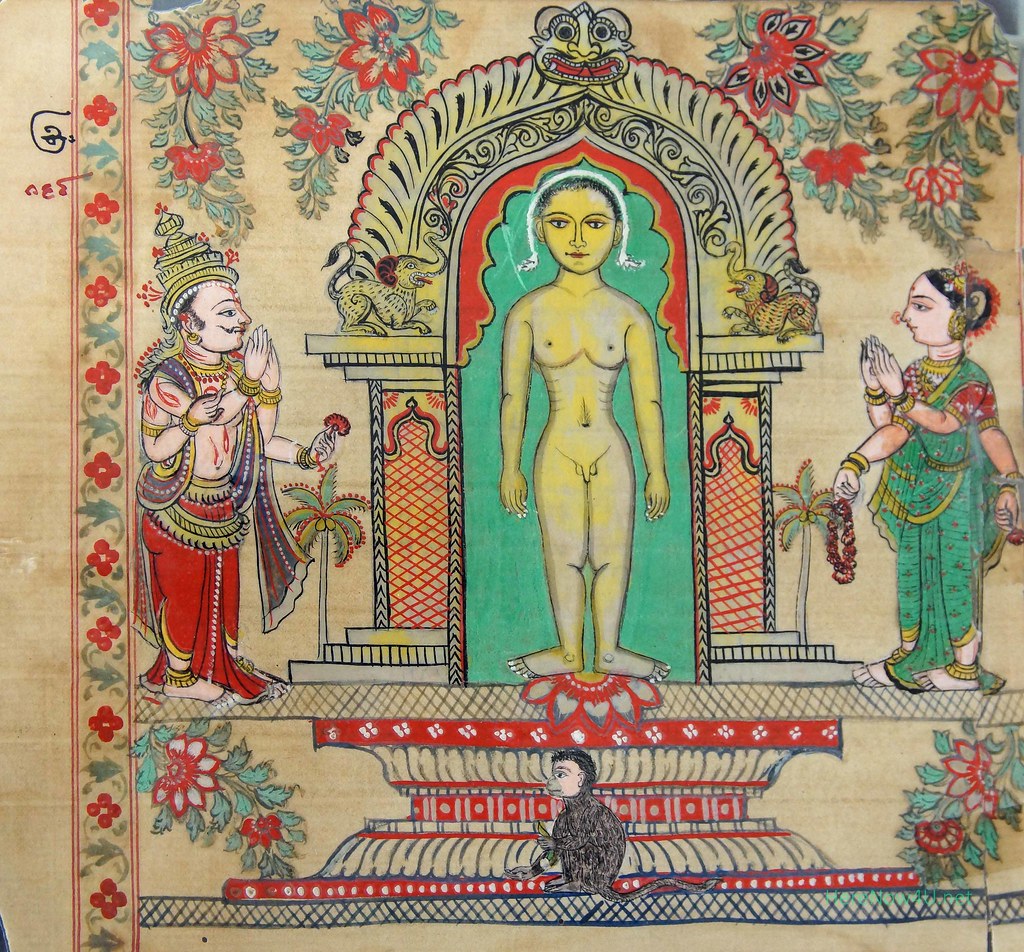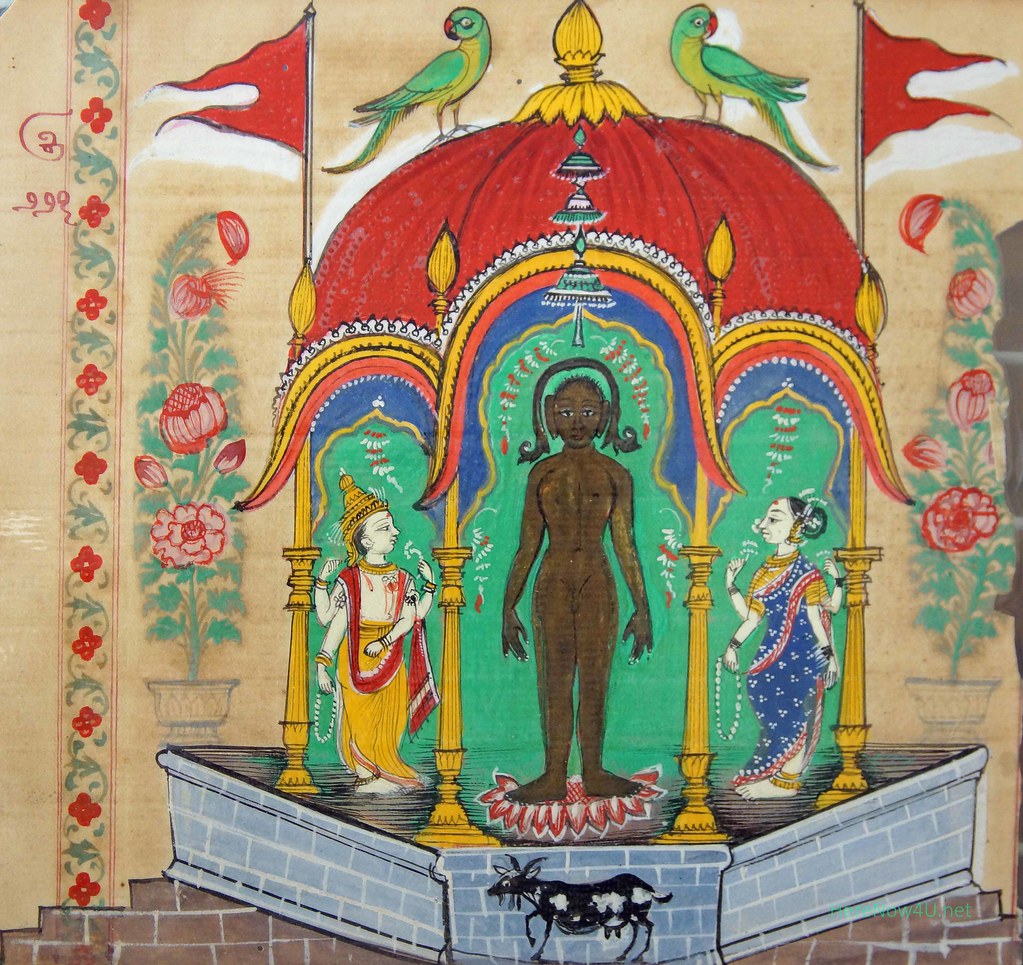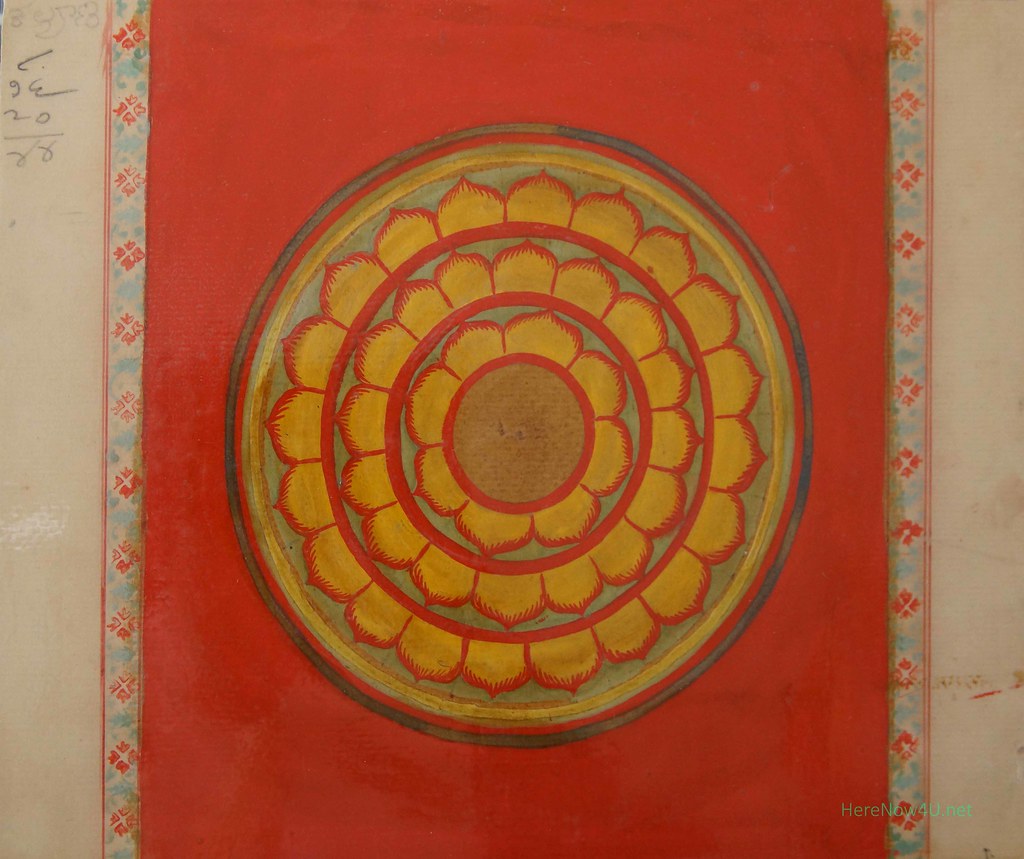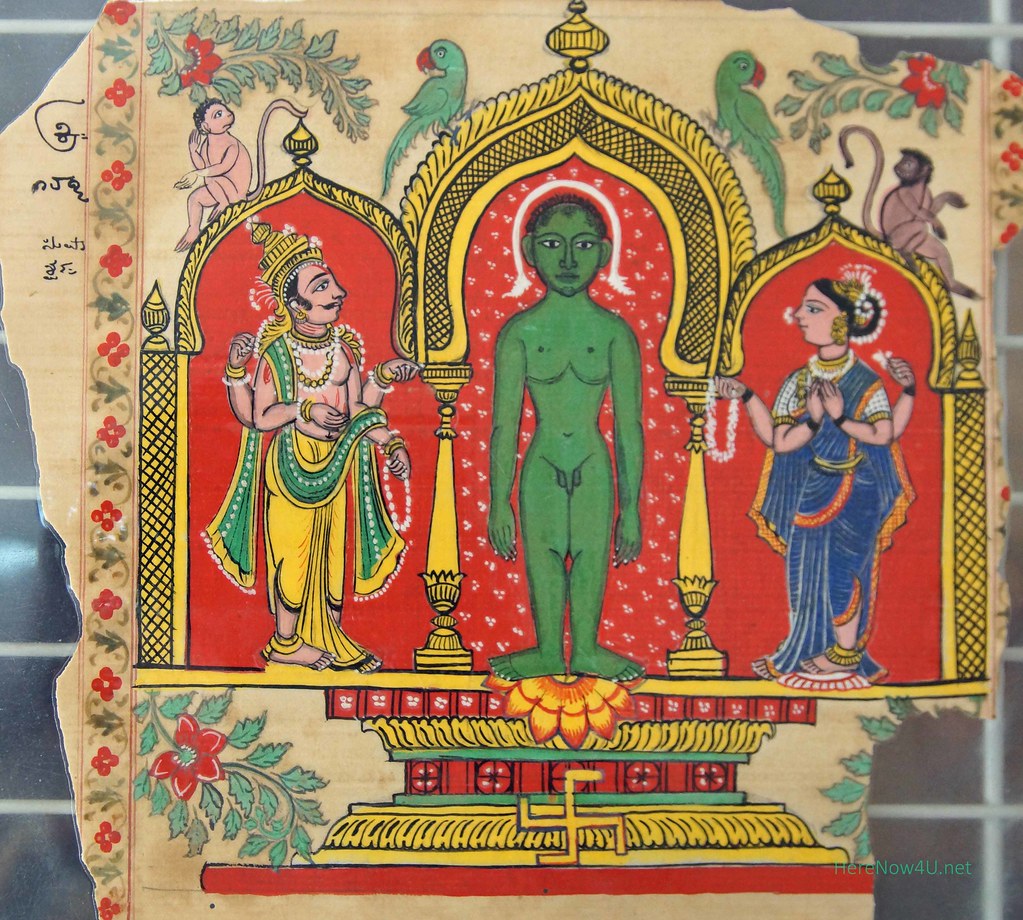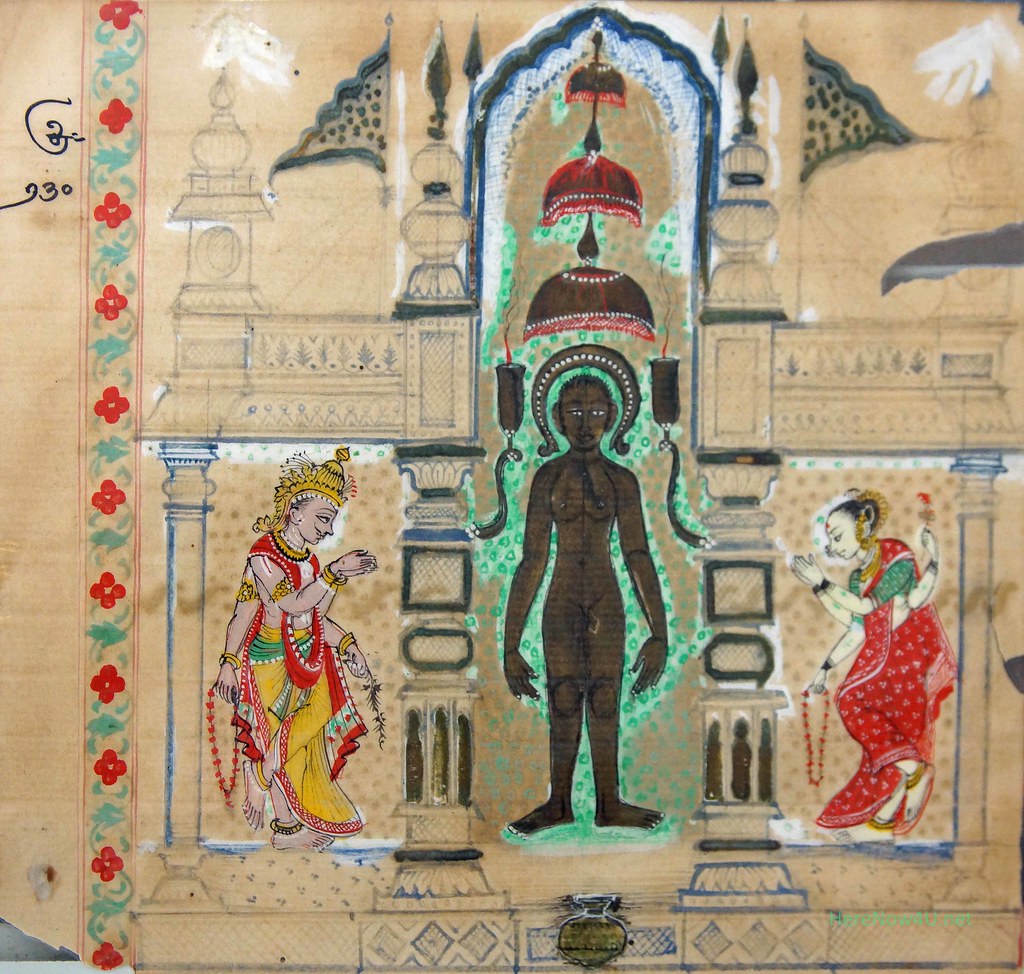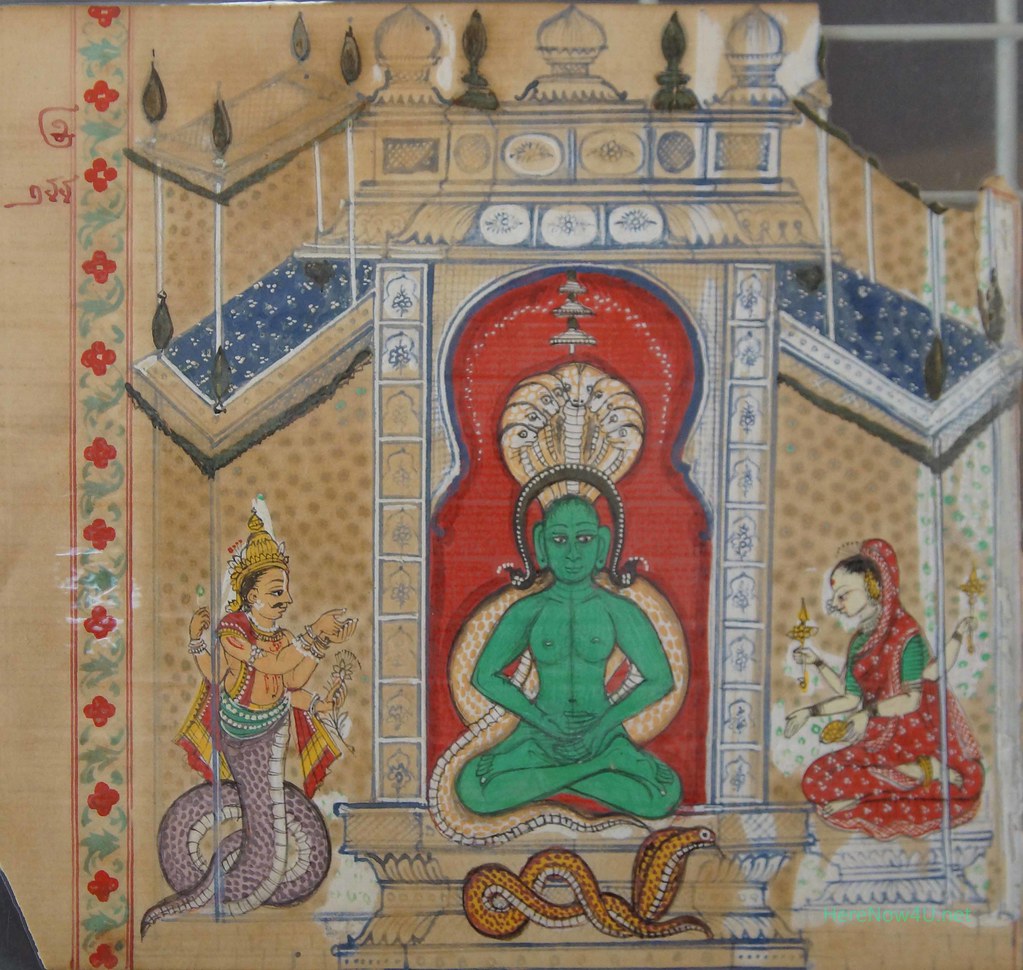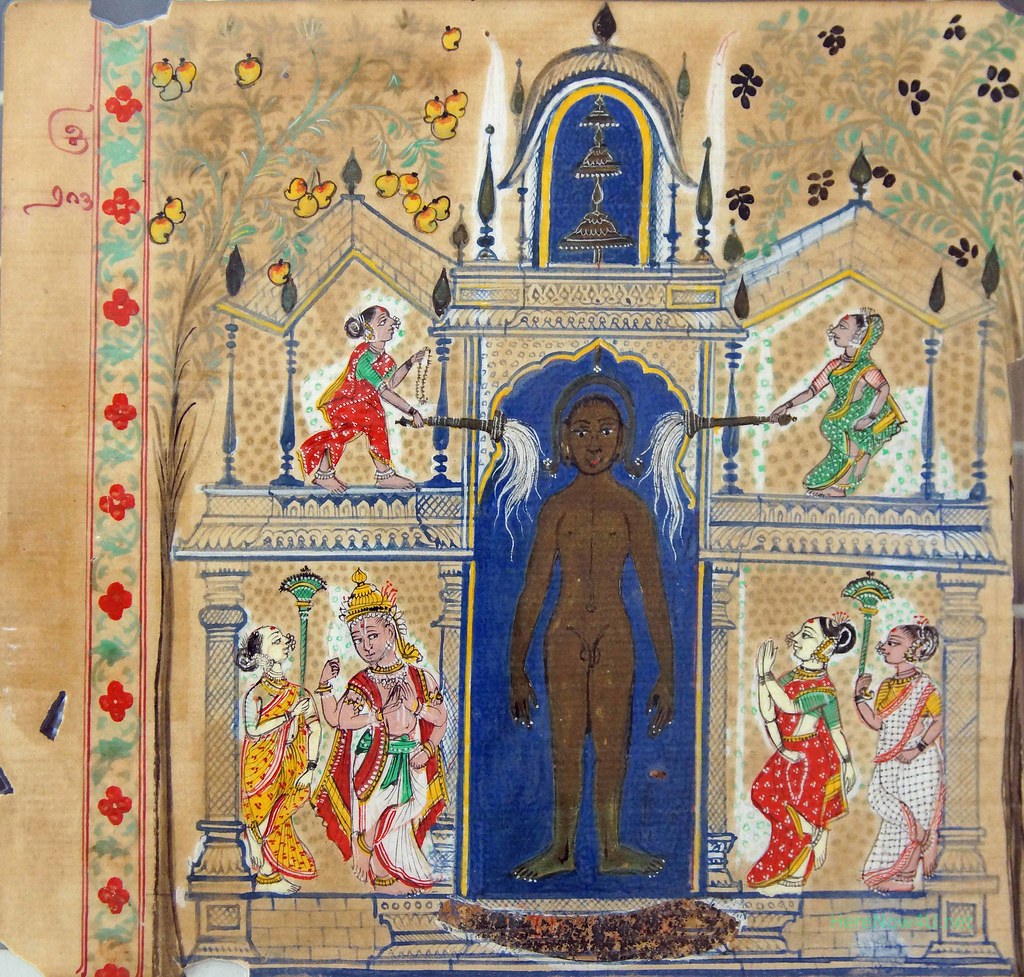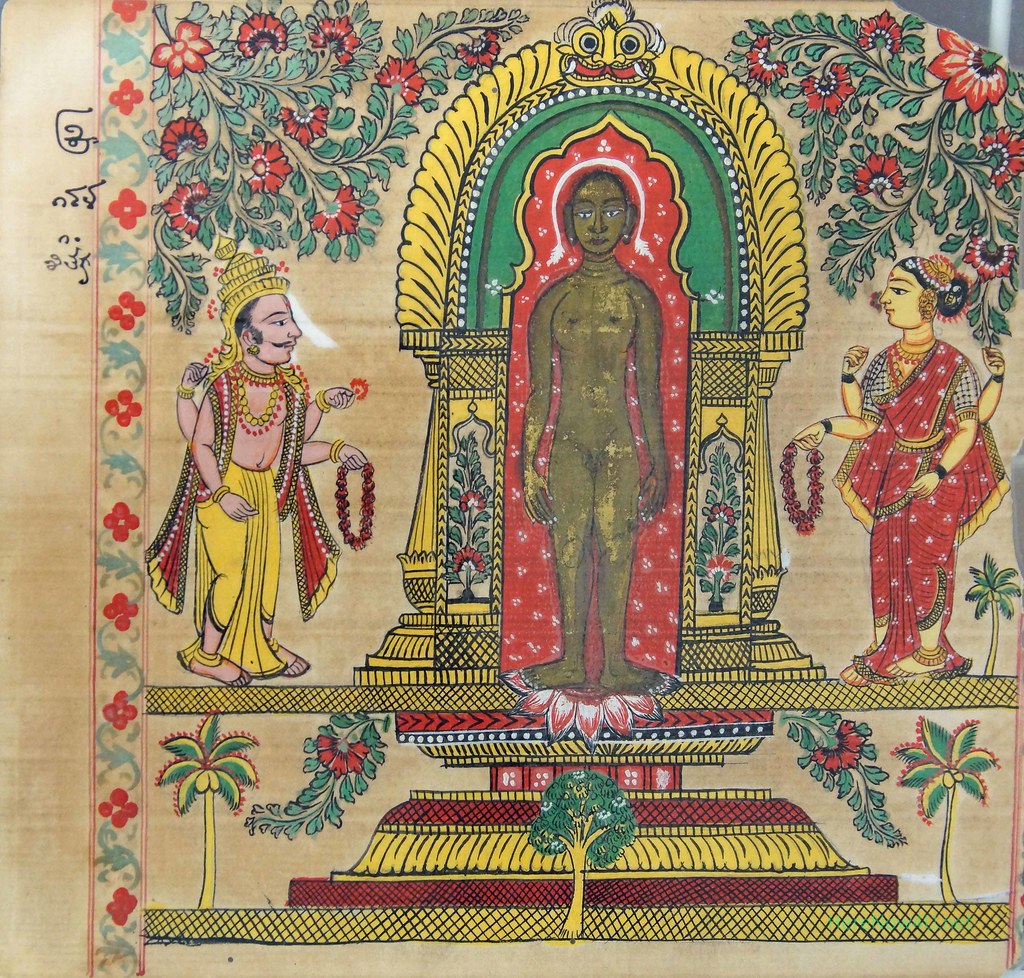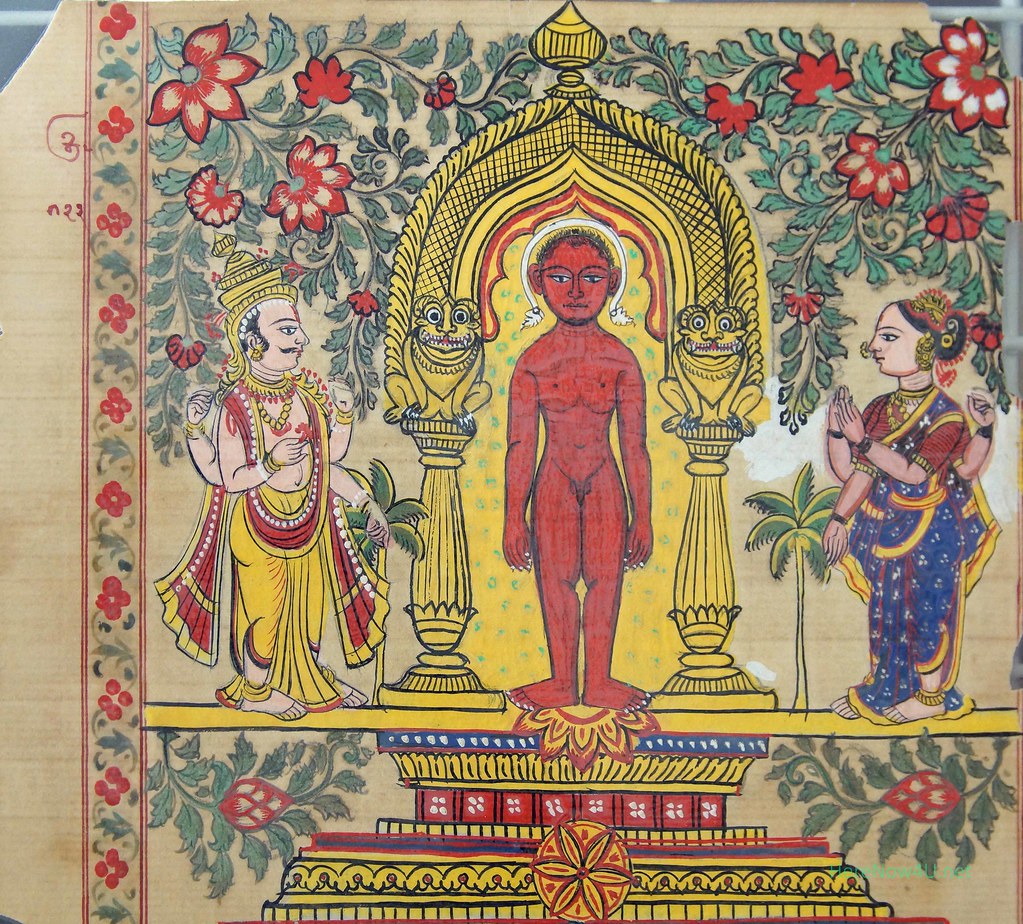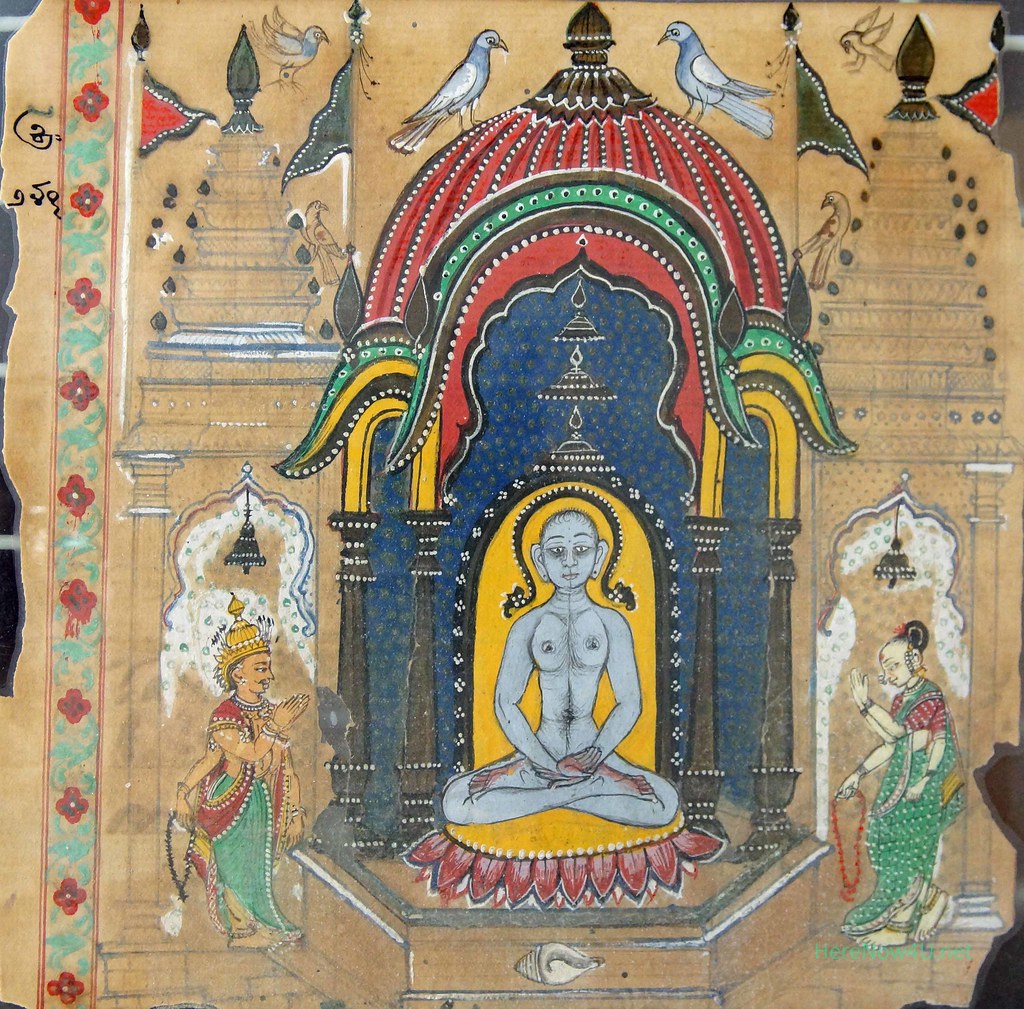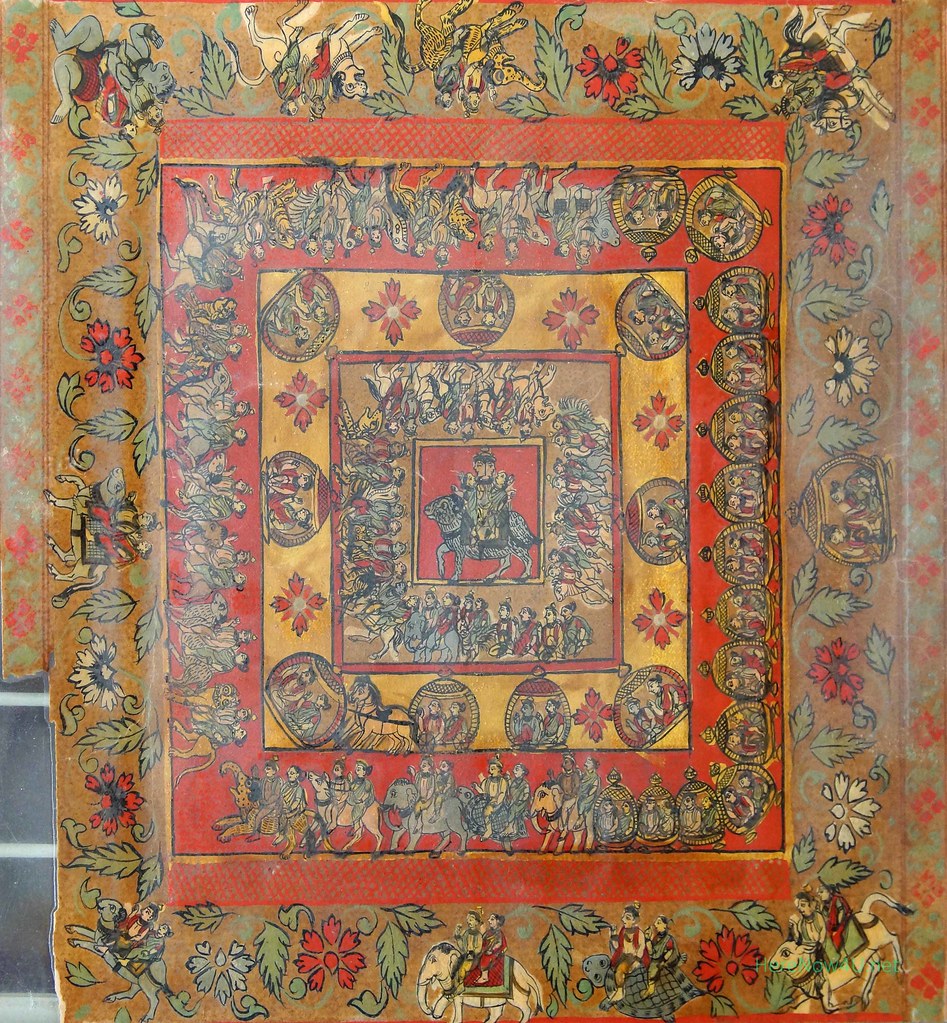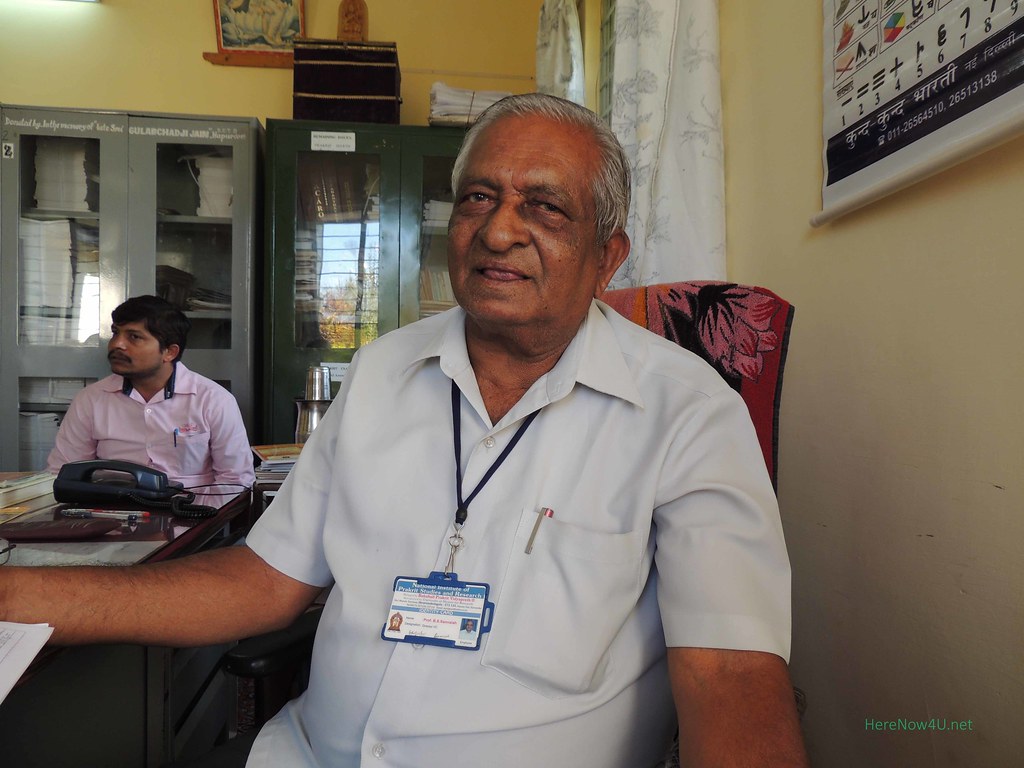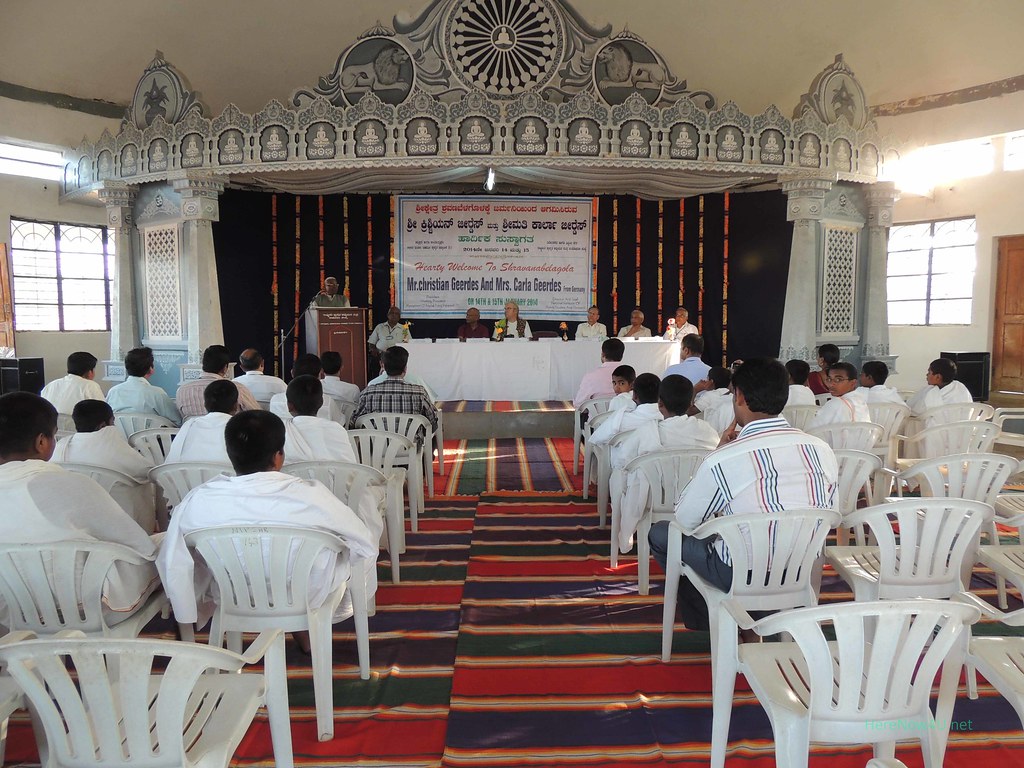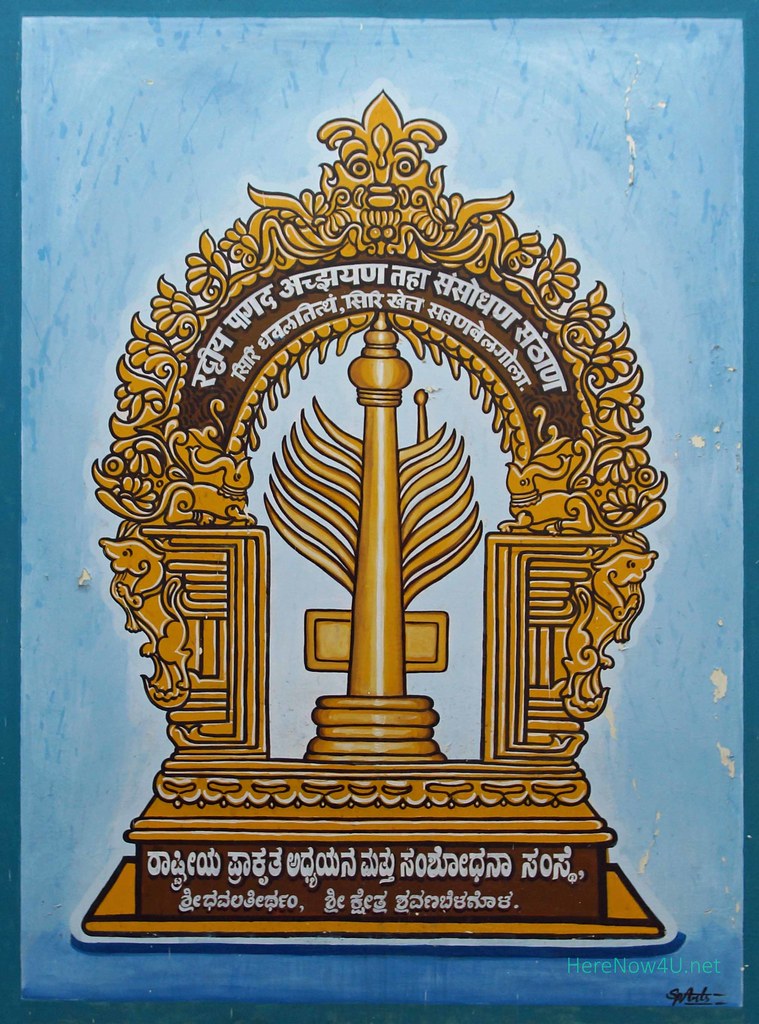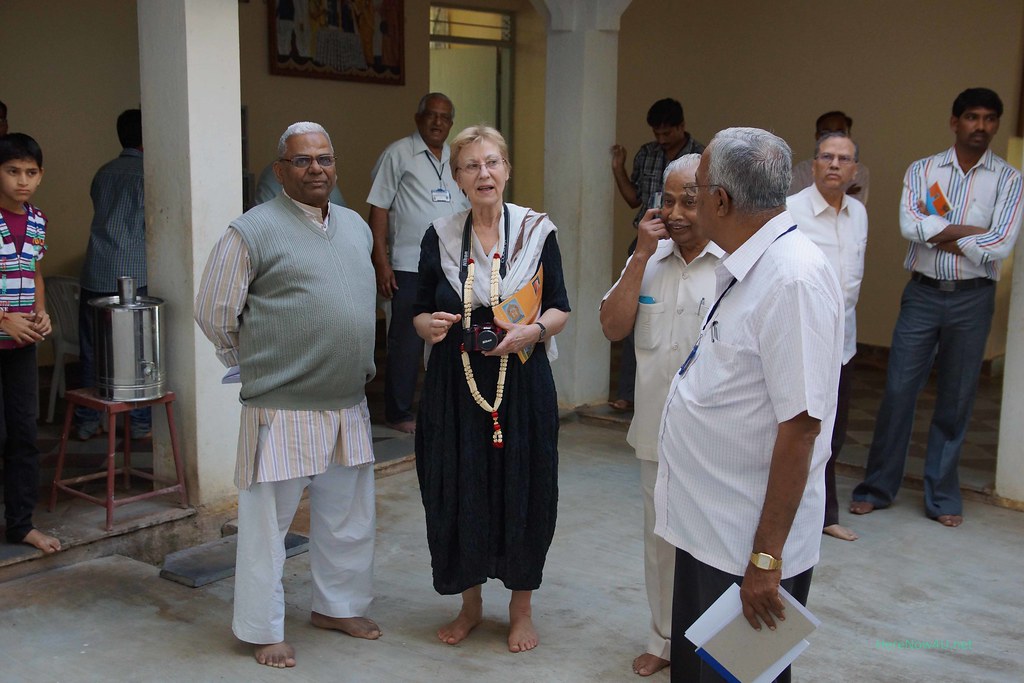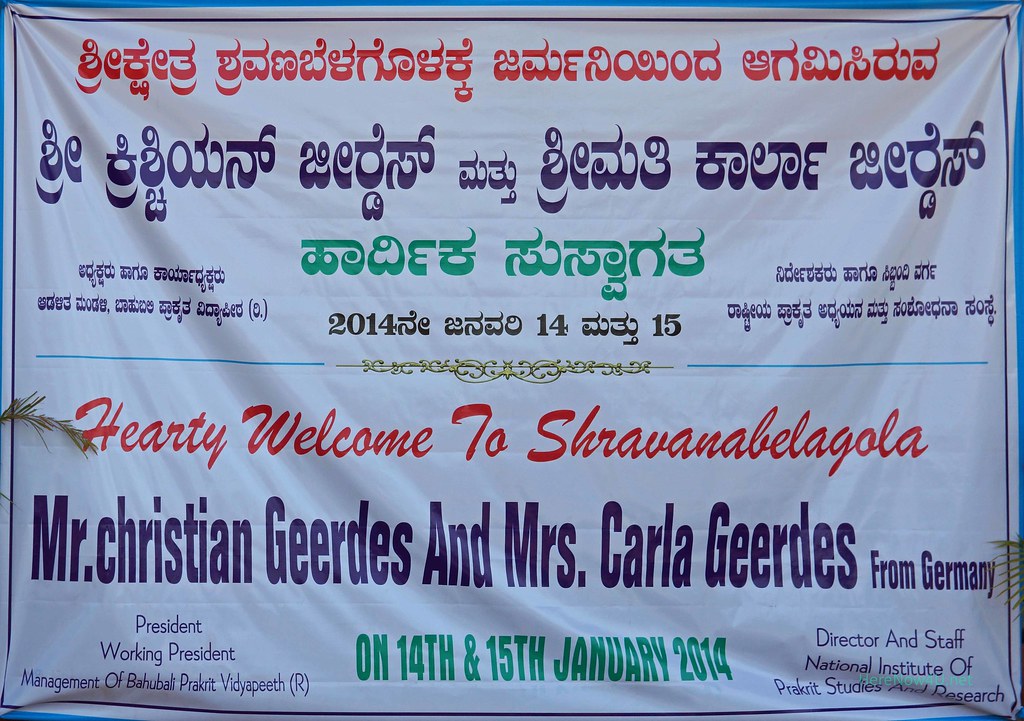After lunch all of us took rest. Then we met again in a room furnished with sofas and chairs on the ground floor of our guesthouse. In a car we were brought to National Institute of Prakrit Studies And Research (NIPSAR), which we had passed already on our way to Shravanabelagola and where our companion Dr. Shanti had boarded. It was a sunny afternoon; the farmers worked on their fields, and the tropical vegetation unfolded all its charm at 25°C. When we stopped in front of the NIPSAR building, there was already a small welcoming committee, beneath them M.A. Jayacandra and M.O. Manjayya. Professor Hampana Nagarajaiah joined them immediately, and what came then we really had never experienced before.
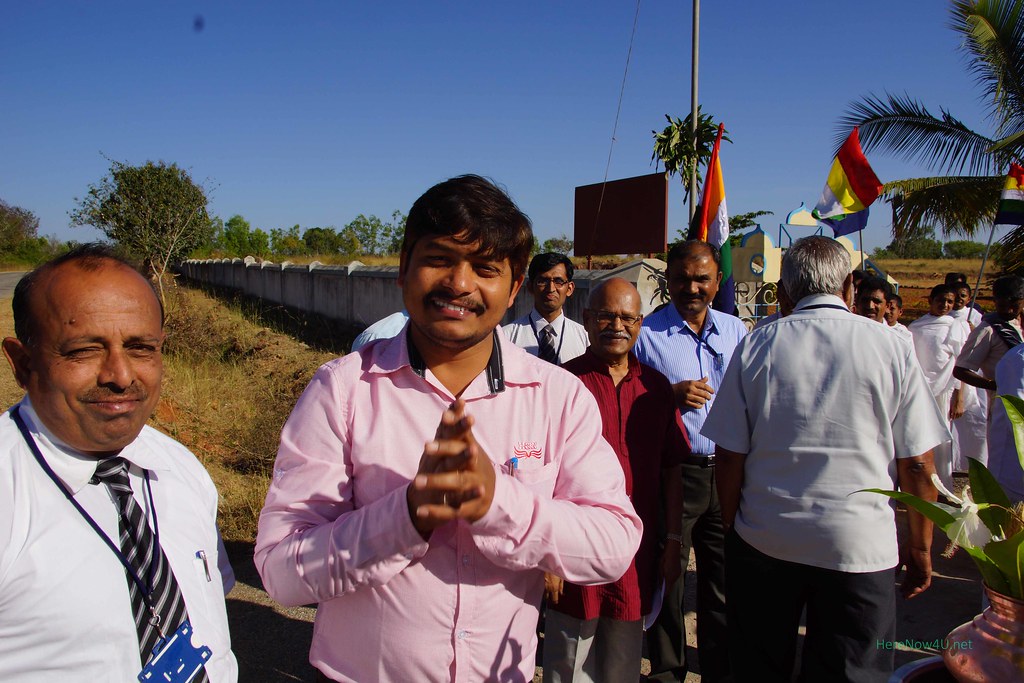 M.O. Manjayya welcoming guests, Prof. Hampa Nagarajaiah in the background
M.O. Manjayya welcoming guests, Prof. Hampa Nagarajaiah in the background
Radiating faces at the entrance under a radiating blue sky
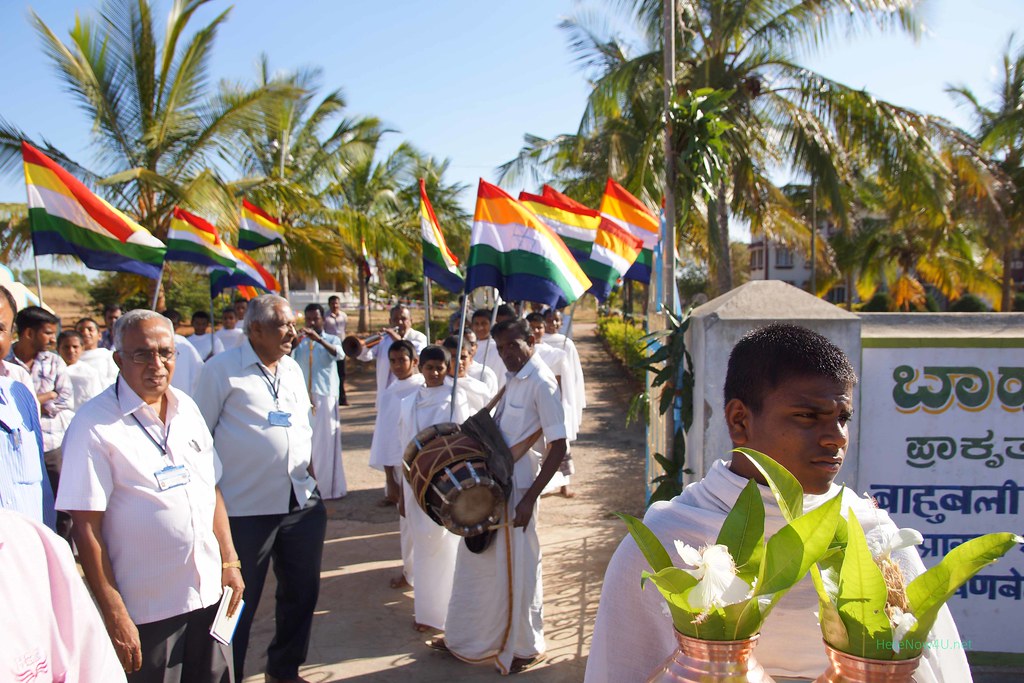
A student of NIPSAR presented a copper jar filled with flowers and leaves and a coconut in each hand to us for welcome
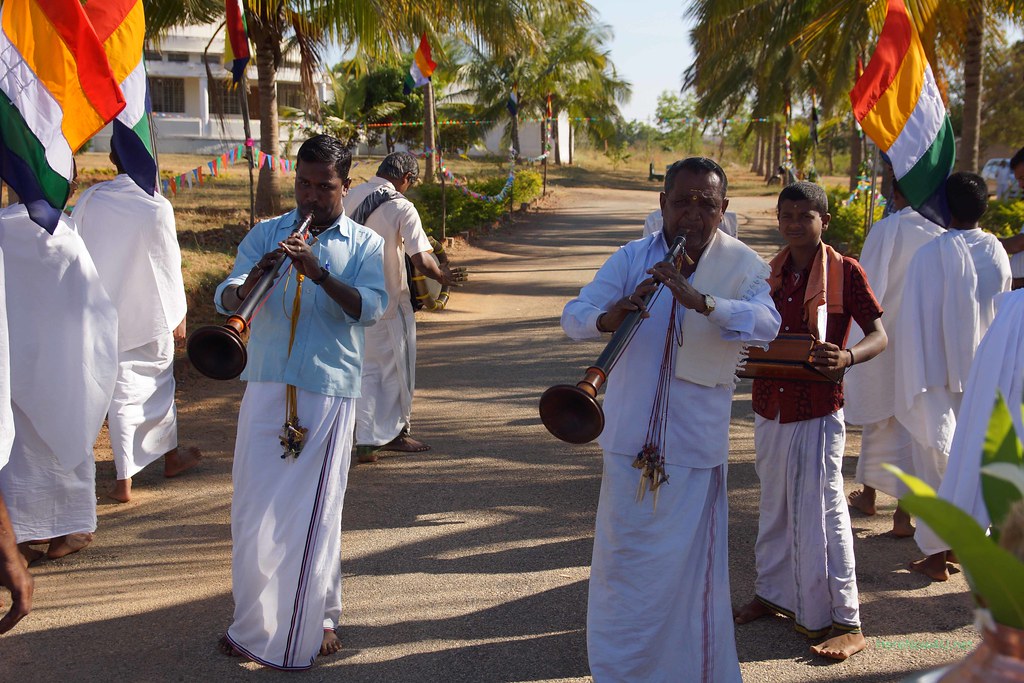
A quartett played traditional music for welcome
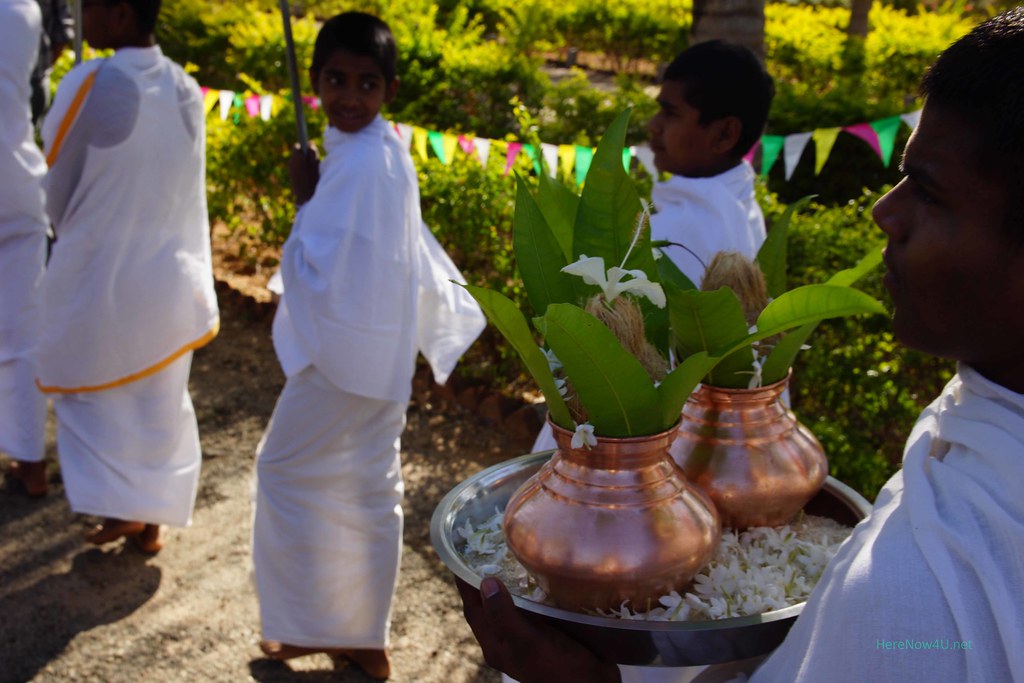
Students accompanied us to the building
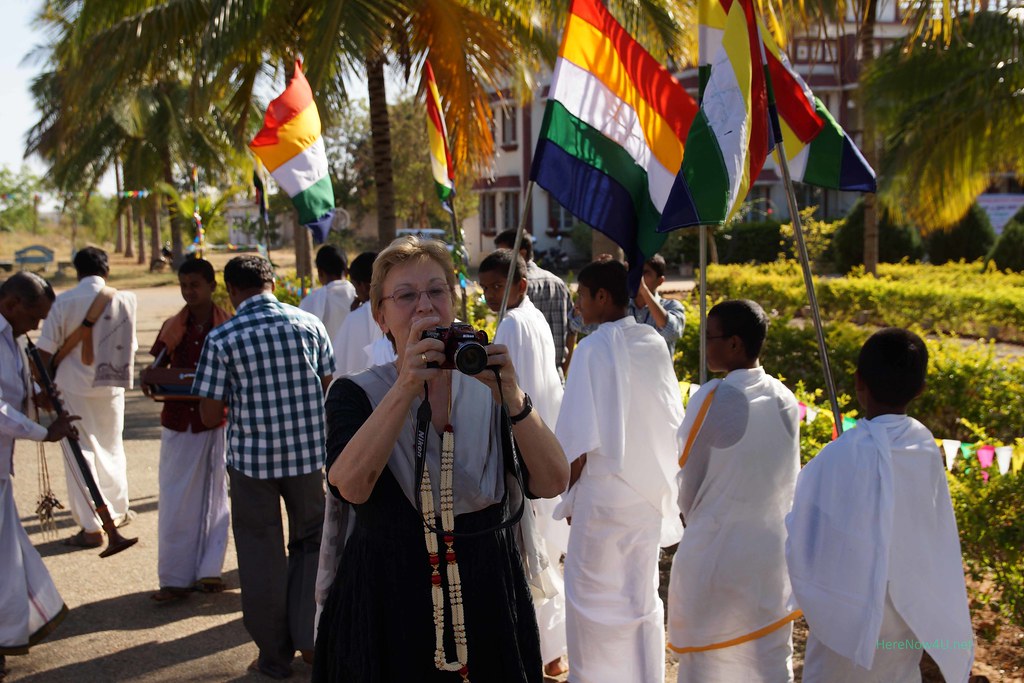
The video being just recorded can be seen below.
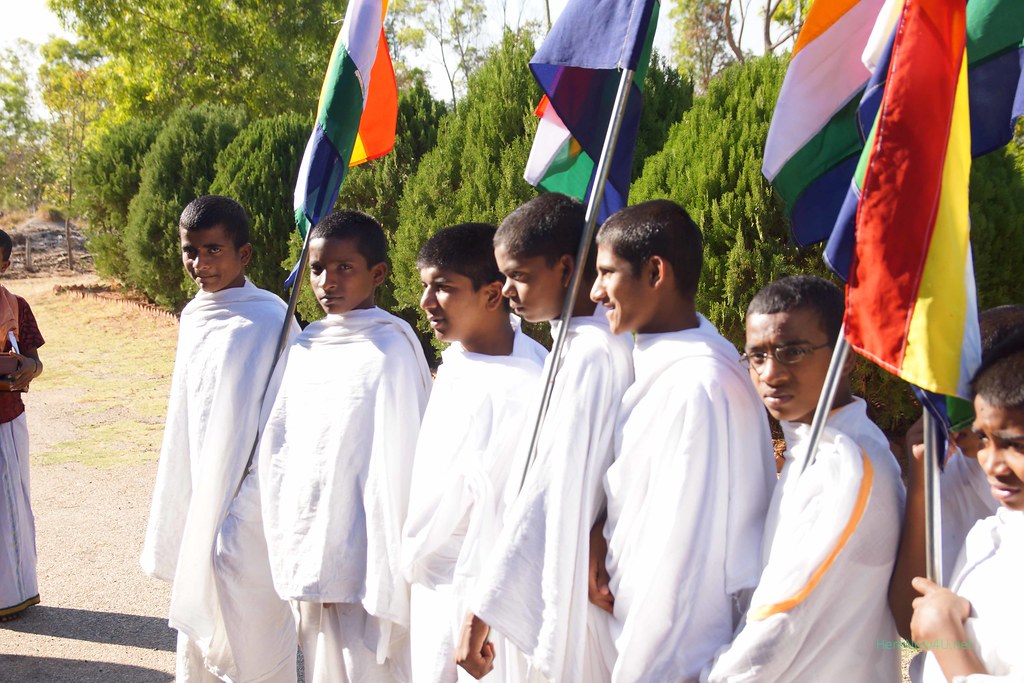
White clad students carrying traditional Jaina flags.
Members of the institution staff, students, scholars and the heads of different departments stood in a row at the entrance of the Prakrit Bhavana Complex. Approaching, we hardly trusted our ears, even musicians were present. All that, to receive us. Certainly we were not prepared to such an affectionate and elaborate welcome when our friend Prof. Hampana Nagarajaiah in the guesthouse handed over a paper with the programme of our visit to Shravanabelagola to us. There simply was written: 3.00 PM welcoming the guests from the entrance of Prakrit Bhavana to Seminar Hall by institution staff students of Gomateshwara Brahmacharya with Mangal Vadya, an expression then unknown to us, meaning with traditional musical instruments. For Mangal Vadya 2 oboes, one big drum and a portable keyboard are required. The quartet played welcoming music. Of course we felt highly honoured and were happy, how much our hosts enjoyed their succeeded surprise.
Video:

Library:
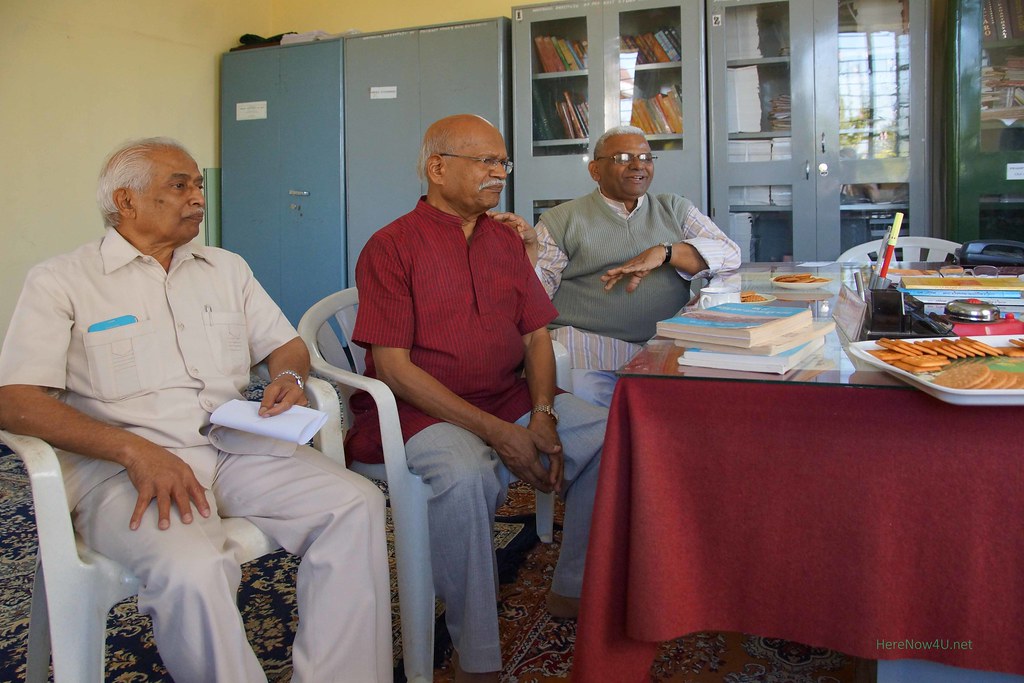 Jitendra Kumar, Hampa Nagarajaiah, Prem Suman Jain
Jitendra Kumar, Hampa Nagarajaiah, Prem Suman Jain
Snacks and tea in the room of Dr. B.S. Sannaiah, curator of the manuscript museum
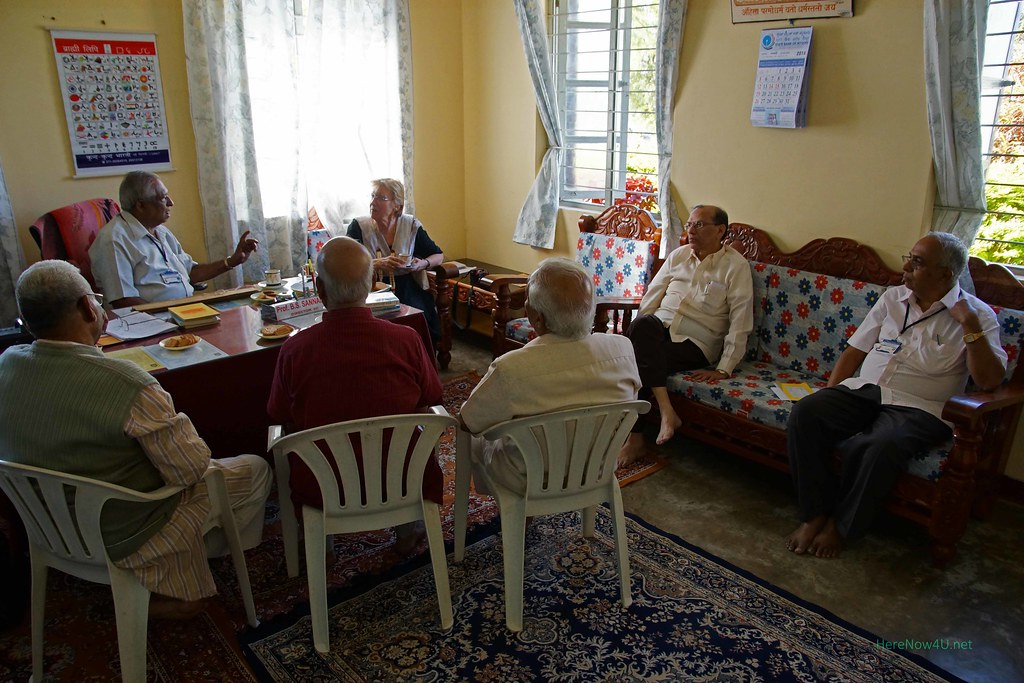 B.S. Sannaiah, Carla Geerdes, M.J. Indrakumar, M.A. Jayacandra
B.S. Sannaiah, Carla Geerdes, M.J. Indrakumar, M.A. Jayacandra
Many interesting details were given on NIPSAR manuscript museum by curator Prof. B.S. Sannaiah when we had snacks and tea
We were seated in the room of the curator of the manuscript museum, Prof. B.S. Sannaiah, were snacks already were awaiting us, as it is custom in the hospitable countries on the subcontinent. After some time, tea was served. We learned that NIPSAR has rooms for academic gatherings, seminars and extended lectures. On the NIPSAR campus there is also a student hostel. One of the main tasks of NIPSAR is beside preservation of palm leaf and paper manuscripts the collection of informations on the same. Meanwhile the latter can be recalled here on about 51,000 scriptures in Prakrit, Apabramsa, Kannada and Hindi not only on different aspects of Jainology, but also on other Indian religions as well as philosophy, grammar, literature, mathematics, astrology, medicine and natural sciences from the 4 southern states of the Indian Union. Plans have been made to enlarge the complex for administrative purposes and teaching facilities, further a guesthouse and accommodation for the staff as well as centres for ayurvedic therapy and yoga. Prakrit Bhavana campus already has been enlarged for 25 acres. At present the focus of the institute’s work lays on categorising, bibliography, translating and publishing manuscripts as well as building up a manuscript museum, for which all scriptures have to be filed, restored and copied. For these enormous tasks to preserve the cultural heritage since 1993, the foundation of NIPSAR, the Indian Federation regularly gives research funds to the Shrutkevali Education Trust which runs NIPSAR.
.
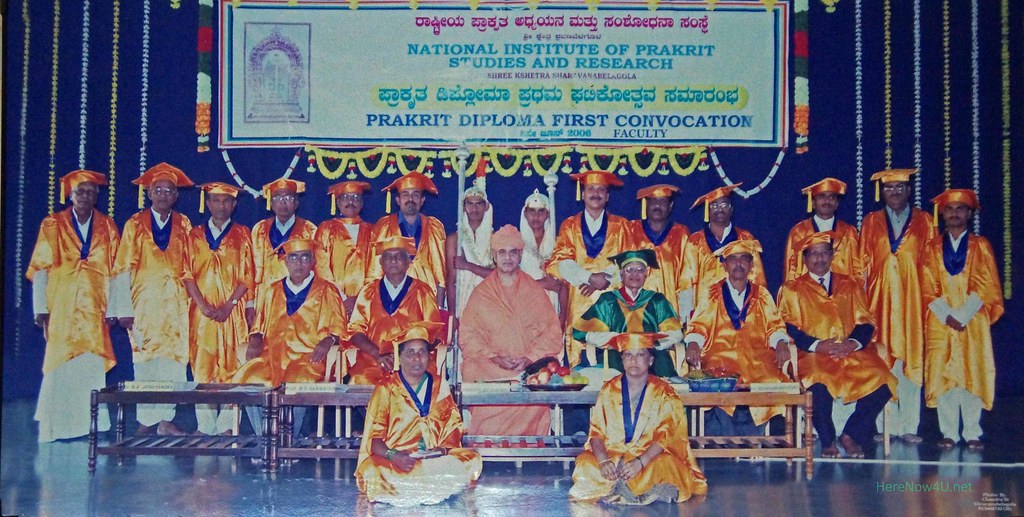
2006 the first diploma for Prakrit final degrees were awarded. Many of the alumni are at present working for NIPSAR.
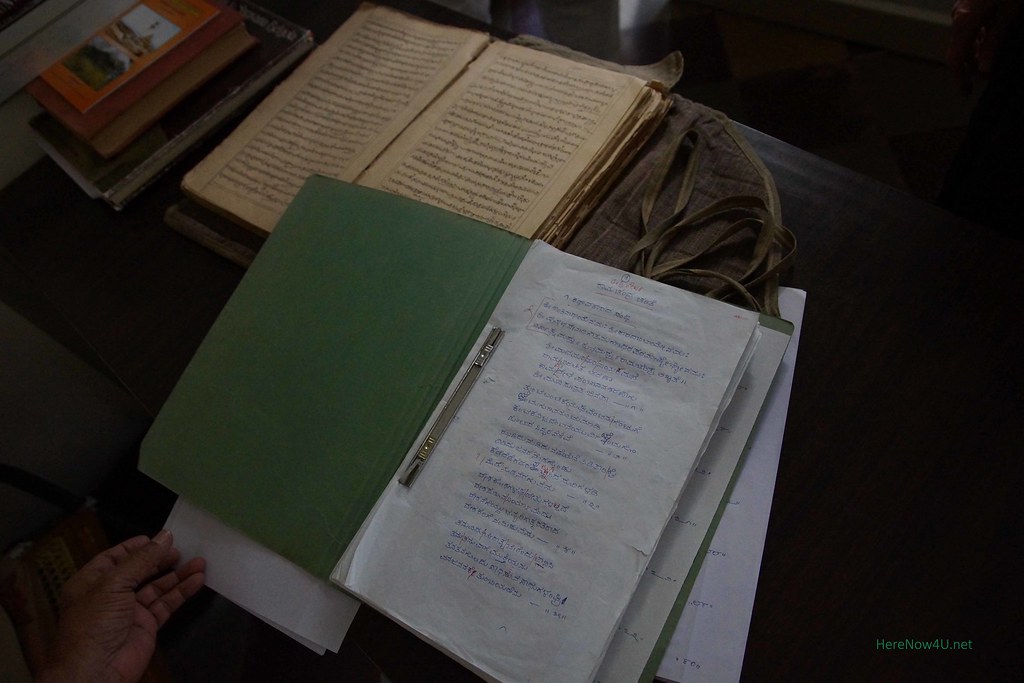
All copies of Prakrit manuscripts have to be handmade,...

... no matter if composed on palm leaves or paper.
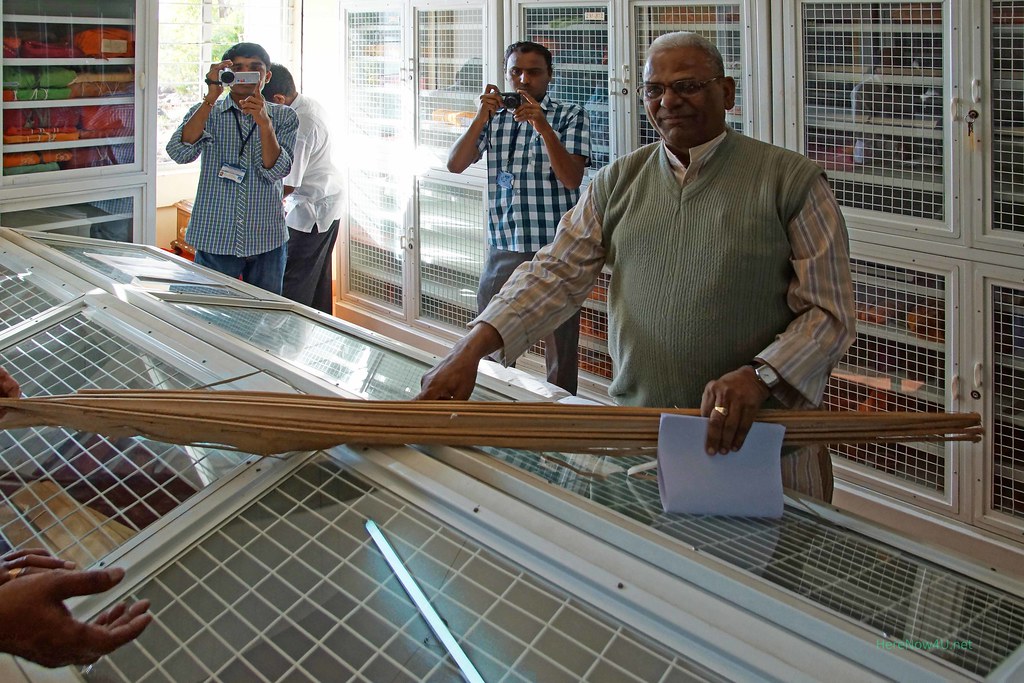 Prem Suman Jain shows how palm leafs were prepared to write on them.
Prem Suman Jain shows how palm leafs were prepared to write on them.
Prof.Prem Suman Jain explains to us, how the palm leaves have to be folded and dried so that lateron they can be used for being written on.
Also Jaina miniature paintings are collected here, each of them a treasure in art history:
:

After the tour of all working rooms in the ground floor we all gathered in the big entry hall for a group photo:
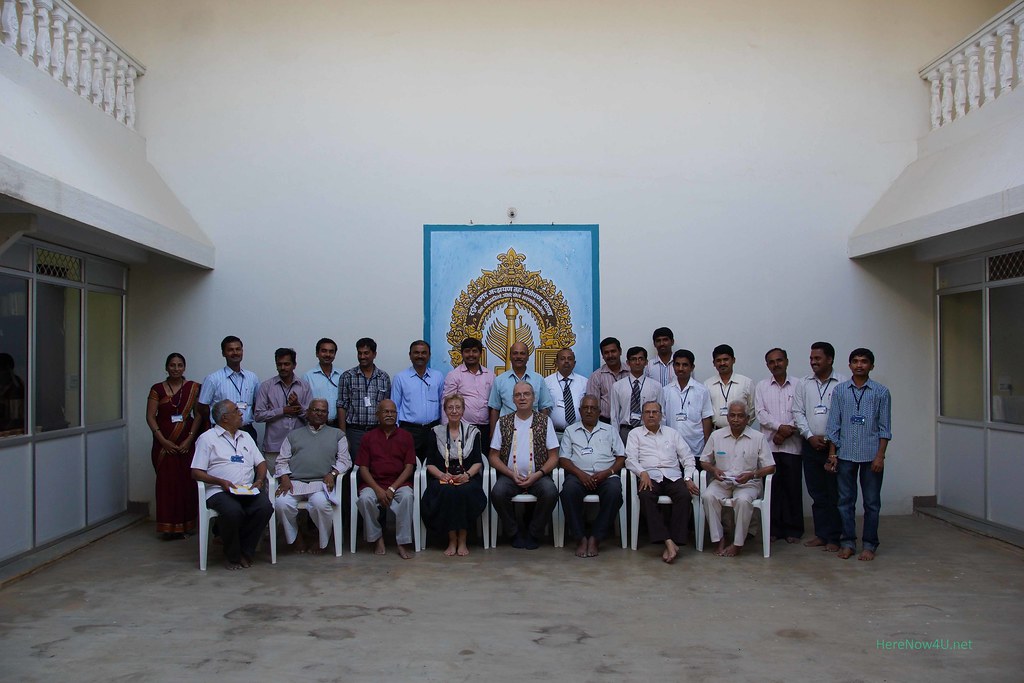
All staff membersas well as national and international guests gathered for the group photo under the NIPSAR Logo.
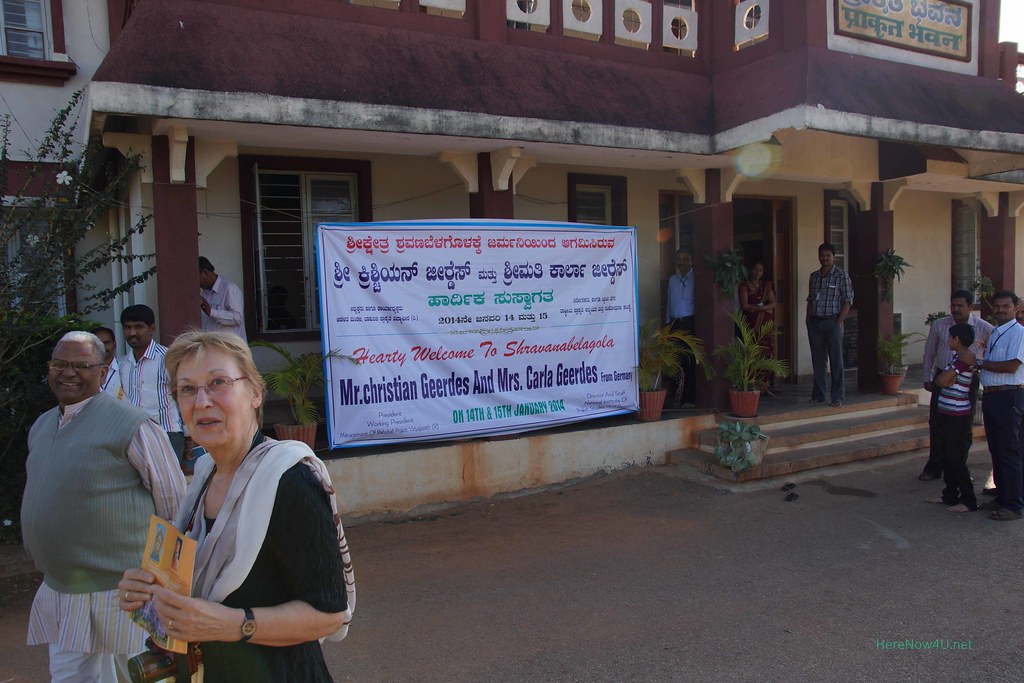
Prof. Prem Suman Jain and Carla Geerdes in front of NIPSAR main building, where a big poster welcomed us.
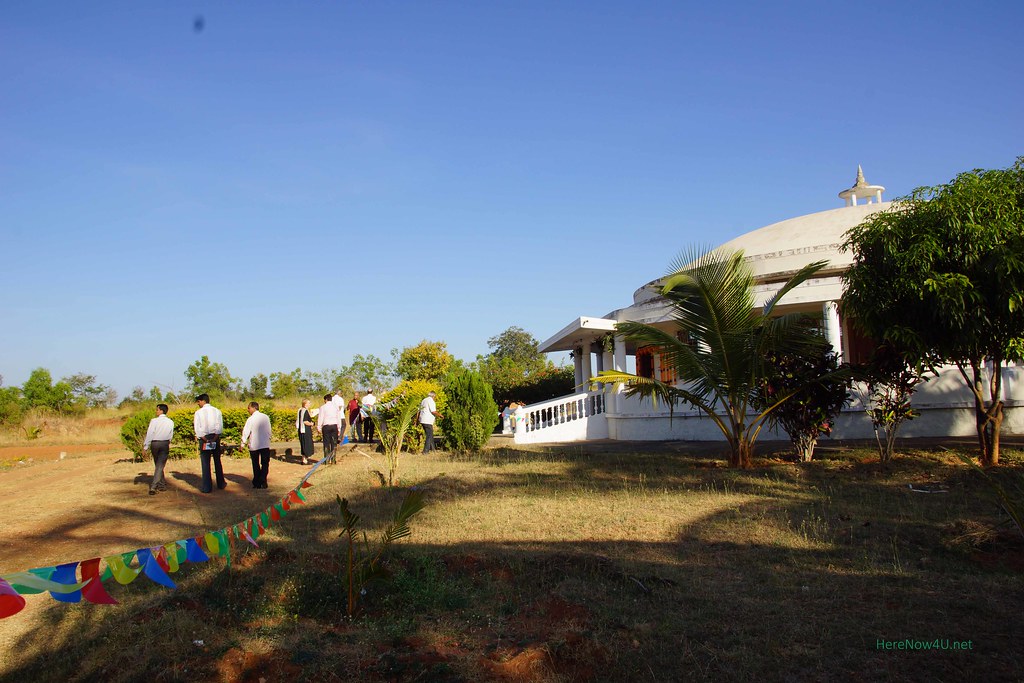
We went a small distance to Prakrit Hall, a spacious round assemblee hall on the campus.

Some students already had gathered there, awaiting us.
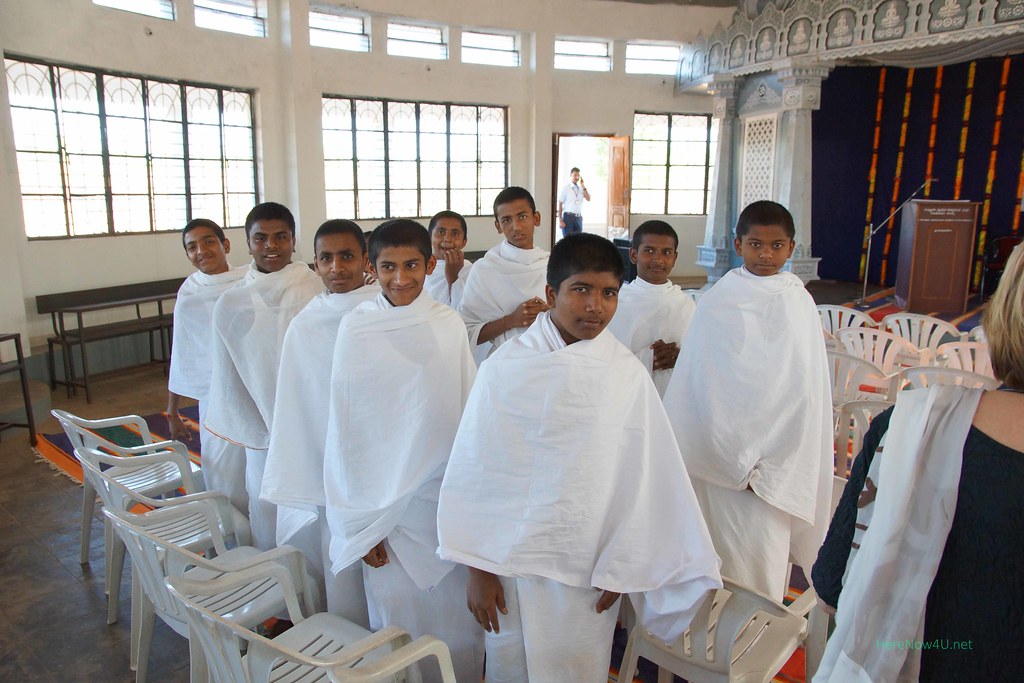
When we entered the hall, they rose...
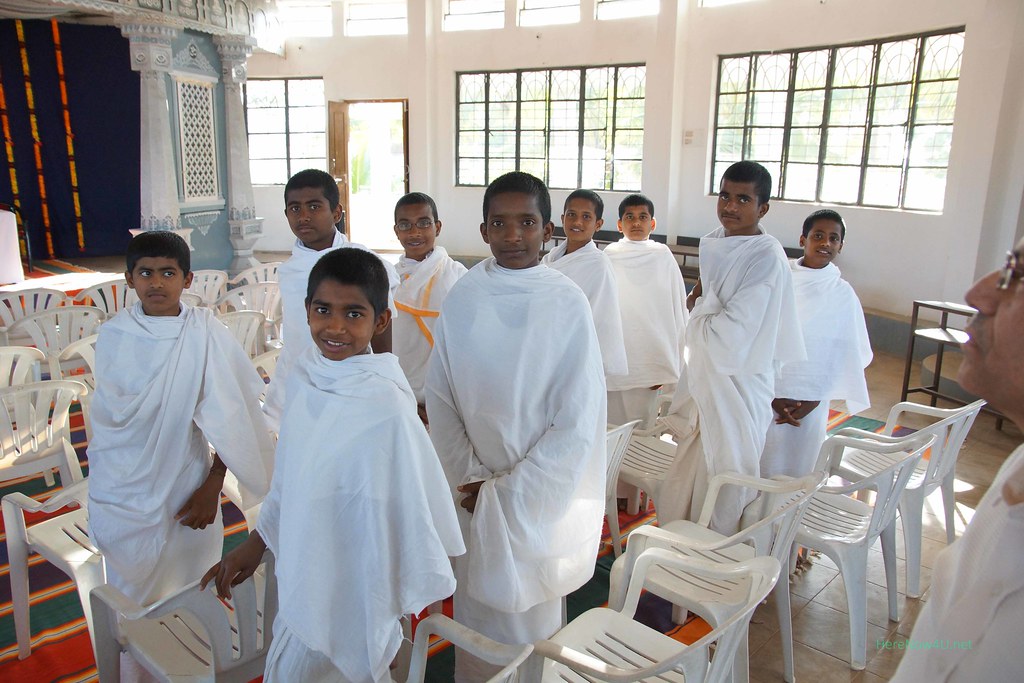
... and smiled at us.
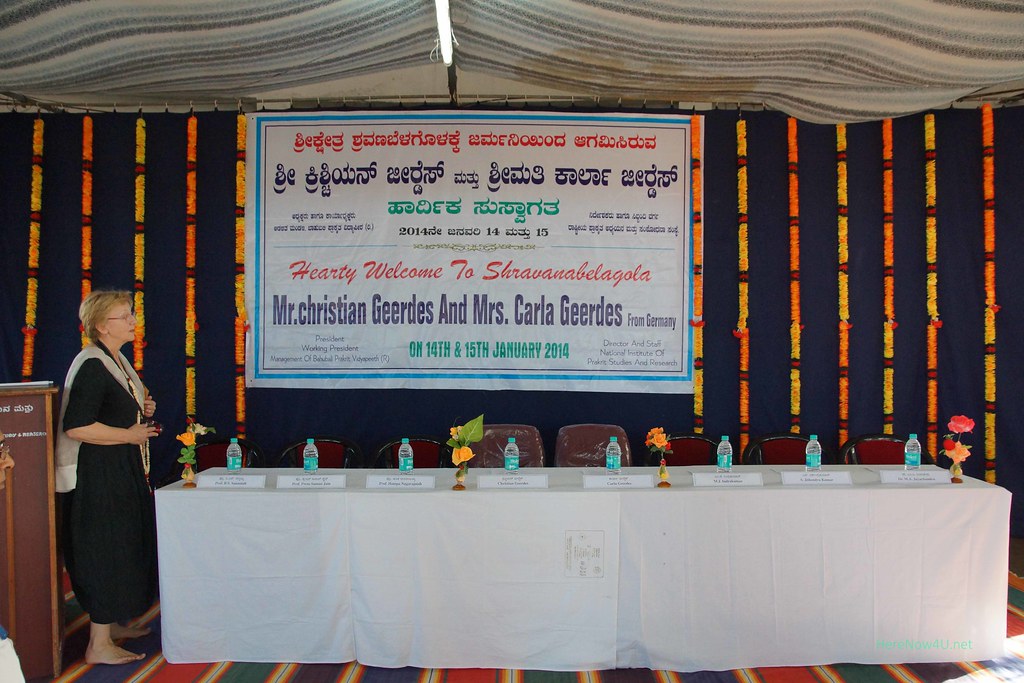
The podium was decorated with flower garlands,...
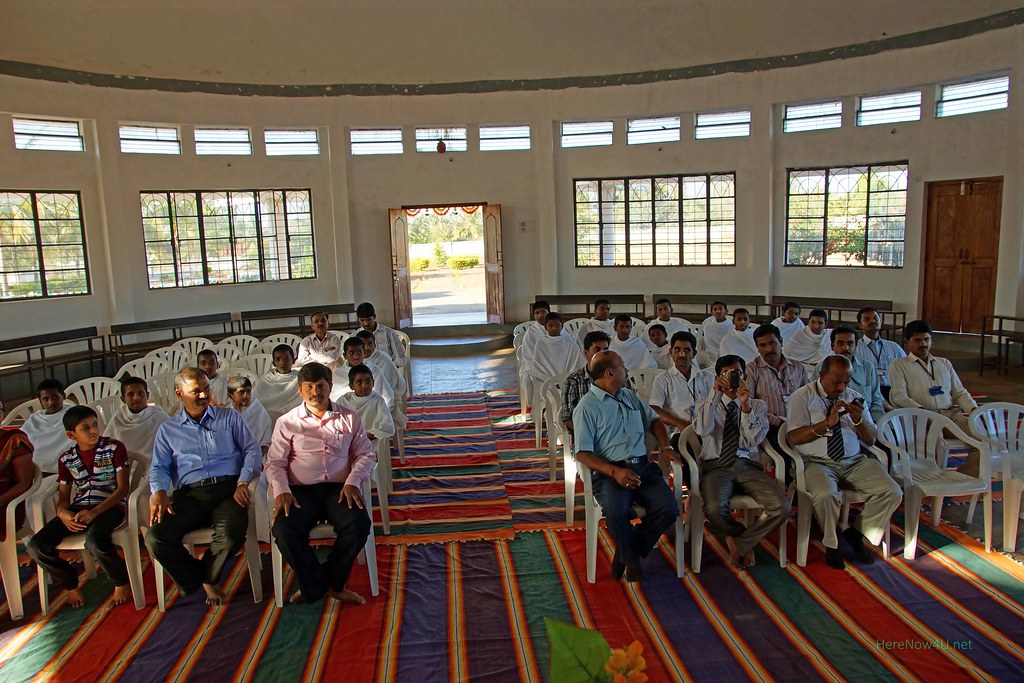
...and meanwhile the audience was seated.
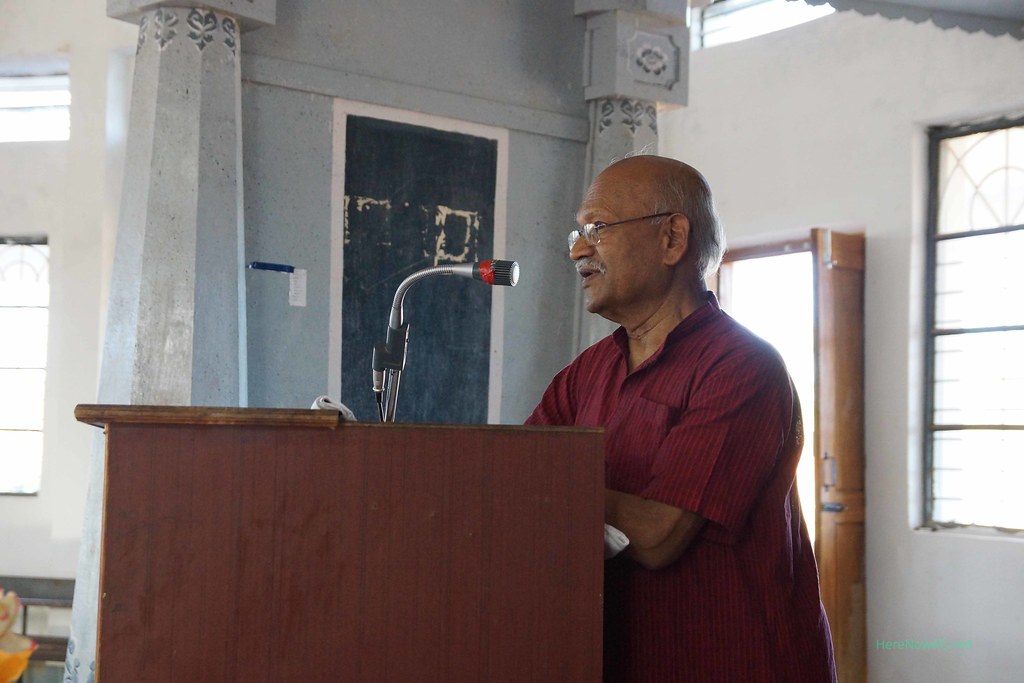
Prof. Hampana introduced us and reported on our work in HereNow4U.
Even Christian Geerdes and I were asked to address the audience. Christian Geerdes spoke on present developments of consciousness in India and Europe. In my address I talked how own lifestyle and environment are impacted by the resolve to turn the back to violence.
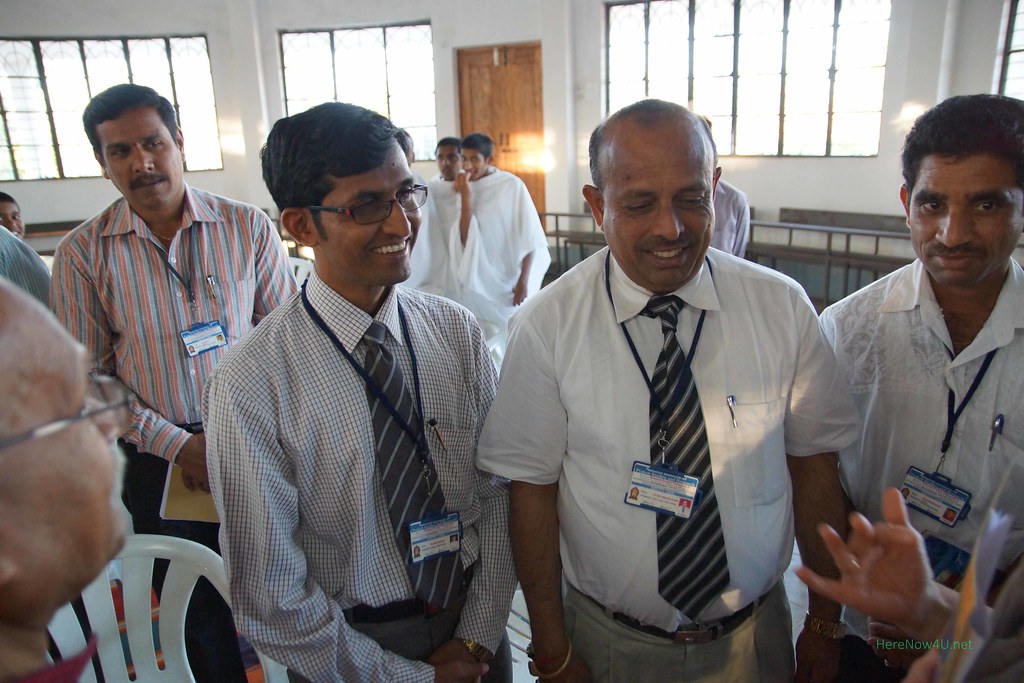
From the audience came many interesting questions.
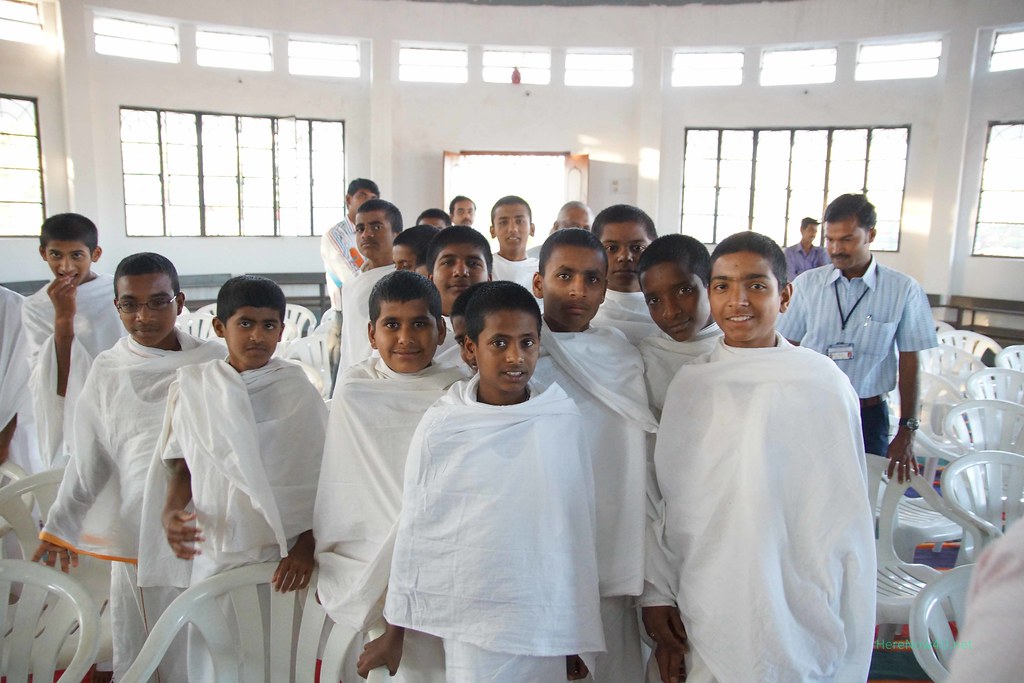
Also the students were very large-minded...
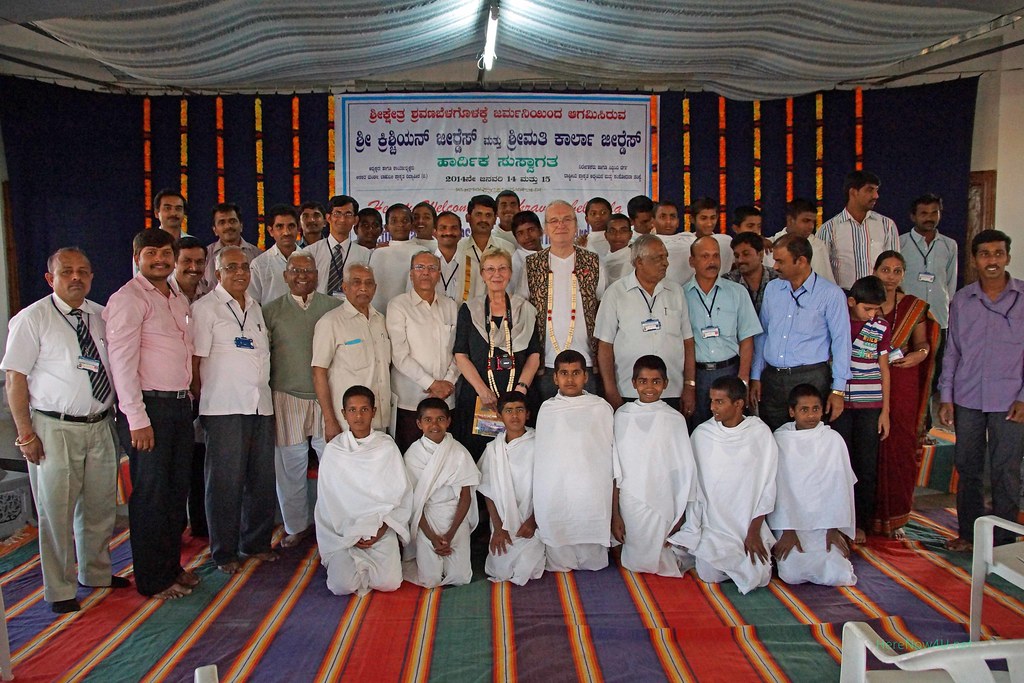
... for the visitors and the group photo for souvenir.
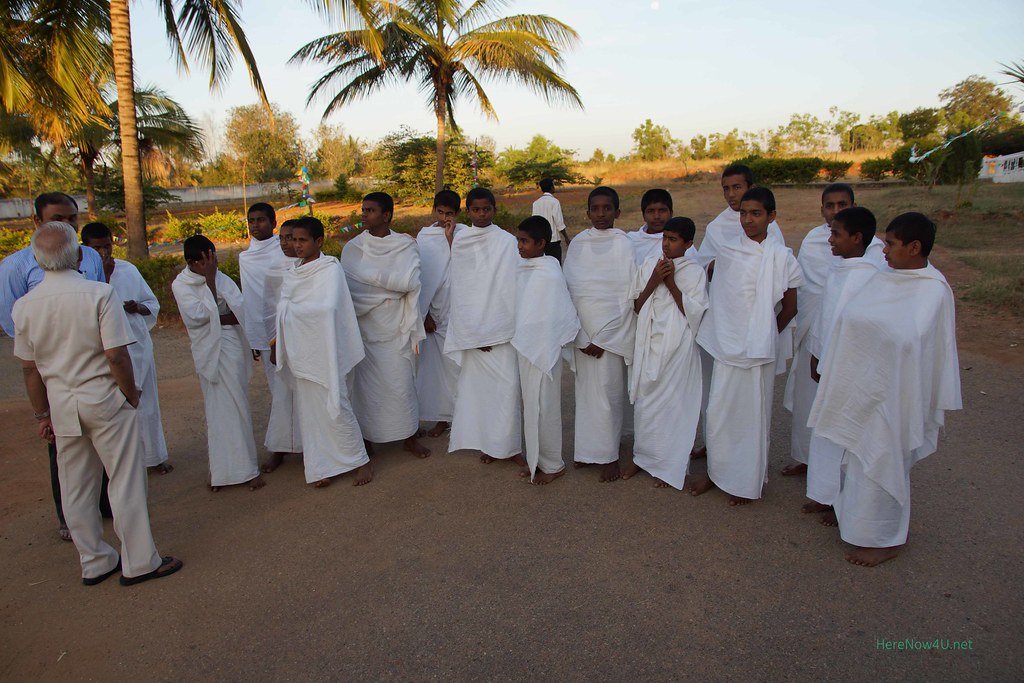
When we came out again, the afternoon sun threw already long shades.
This afternoon we had learned a lot on work, main tasks and even plans for the future of NIPSAR. Most admirable the spiritual and mental energy of His Holiness Karmayogi Swasthishri Charukeerthy Bhattaraka Mahaswamiji behind NIPSAR. His visions and dynamic management were the guiding forces for all these activities of concentrated coaction of so many learned people. Cooperation, mutual support and dedication for the common sake are really practised in Shravanabelagola and made each and every one of them part of a complex
 Editor Carla Geerdes
Editor Carla Geerdes
